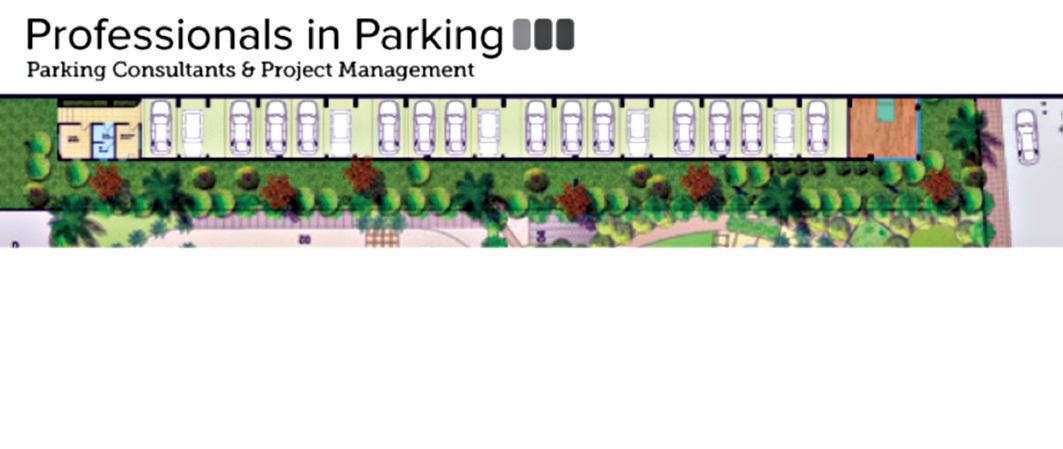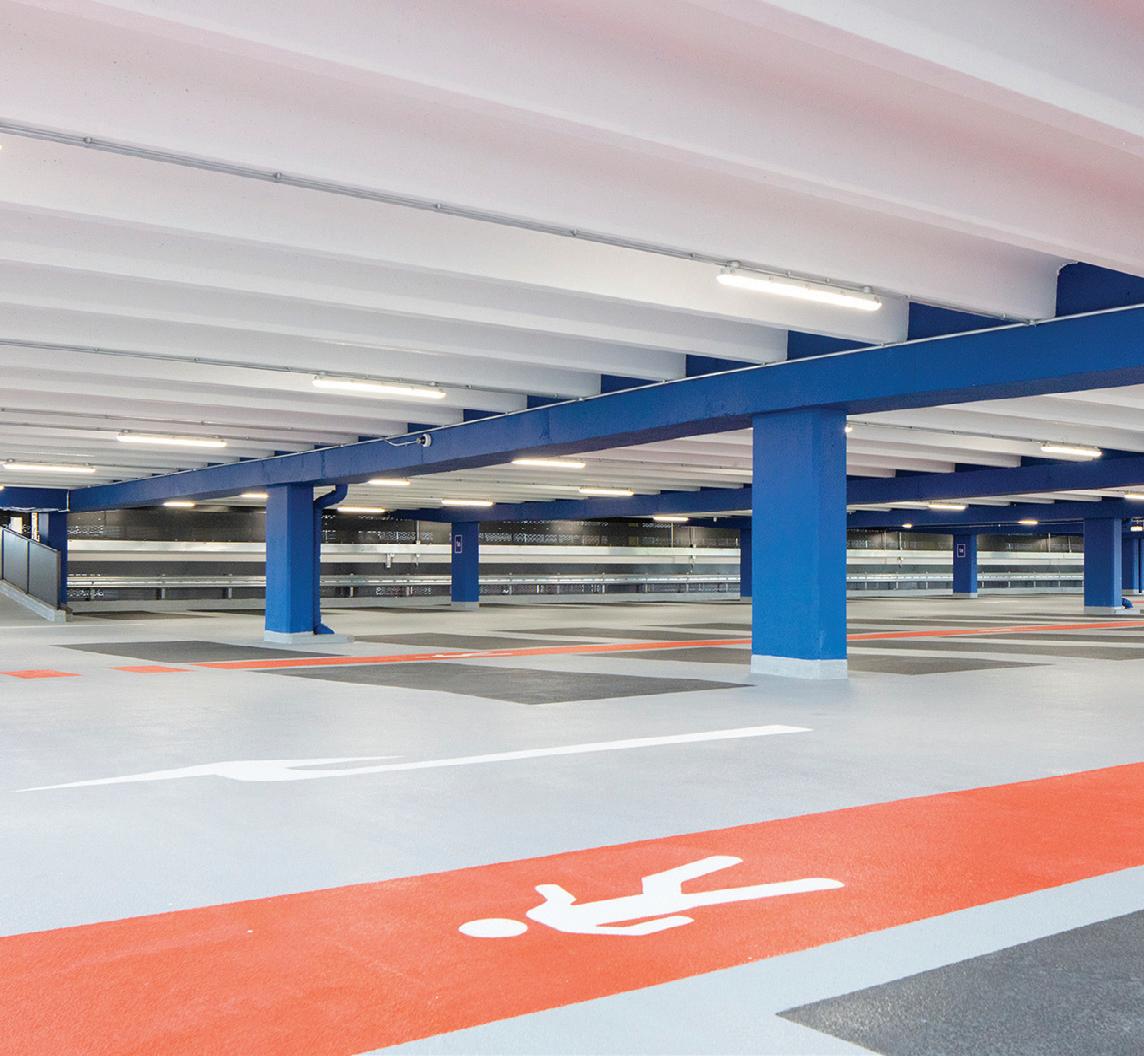T HE GREEN M A N

Smarter parking will support sustainable mobility, says Peter O’Driscoll



Smarter parking will support sustainable mobility, says Peter O’Driscoll

Conferences are a chance to rekindle old relationships and make new friendships
The return of real events brings a buzz back to working life

In recent weeks I have found occasion to feel frustrated while working my way through the throng in the local supermarket, but also pleased to find an empty seat in a pub beer garden on a warm Bank Holiday afternoon. I have been booking tickets for gigs, the theatre and even a holiday. What are really quite mundane moments from my life feel quite momentous. They signal that life is getting back to some semblance of normality after years – yes it has been years – of lockdowns. The habits and customs of our former lives are returning, albeit unevenly. Packed terraces at football matches and the buzz around who will be playing at Glastonbury indicate that the social side of society is re-establishing itself. But what of the world of work?
For many of us working from home is still the norm, though many organisations are encouraging employees to return to the office, if not full-time then at least on a regular basis. As for workers, after so many hours video conferencing, many are keen to engage with colleagues and clients face-to-face, having missed the creative energy and camaraderie that arises from team working. And, for some people, offices provide a more structured, and quieter, working environment than a spare bedroom or the kitchen table.
That said, there are many good things about working from home, especially where it enhances family life or replaces a long commute. It’s thus likely that hybrid working arrangements which capture the best bits of both homeworking and office life are likely to become commonplace.
The easing of lockdown and pandemic restrictions also means conferences, seminars and exhibitions are back. During the pandemic webinars have become a mainstream means of sharing information, but virtual events cannot replicate the energy, intimacy and serendipity that comes from attending a live event. Consequently, it will be nice to see many parking people at the NEC in Birmingham for Parkex 2022. Meanwhile, I am enjoying programming two live events: the new Mobility Hubs conference, which takes place in London on 25 May; and the Enforcement Summit at Edgbaston Stadium on 28 June.
Conferences and trade shows offer not just knowledge and networking opportunities, but a relaxed environment where existing relationships can be rekindled and new friendships started over good food and with a nice drink. Speaking of which, remember the British Parking Awards 2022 is live!

 Mark Moran Editor
Mark Moran Editor


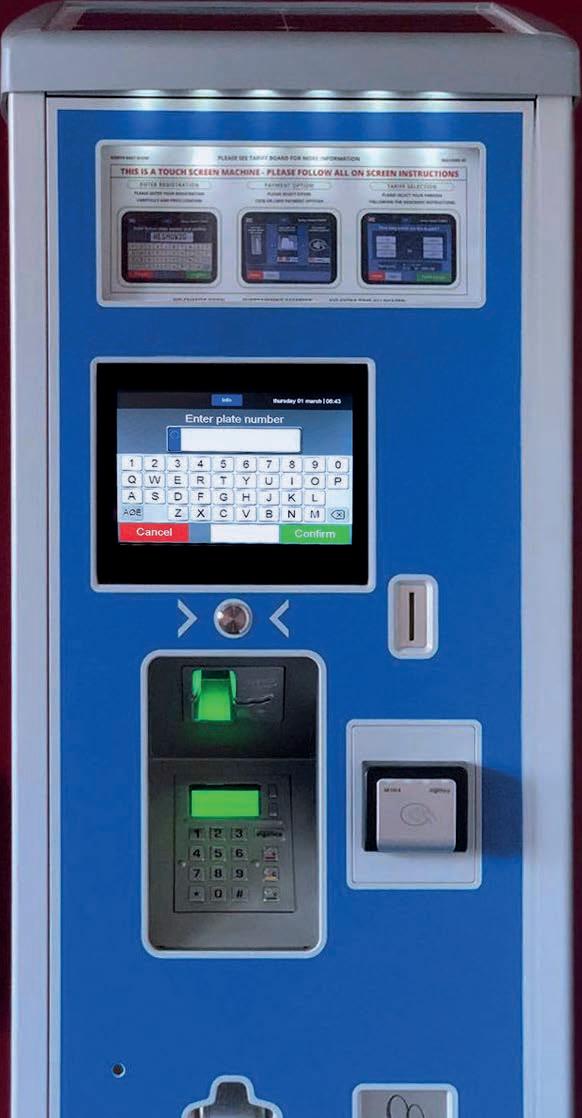













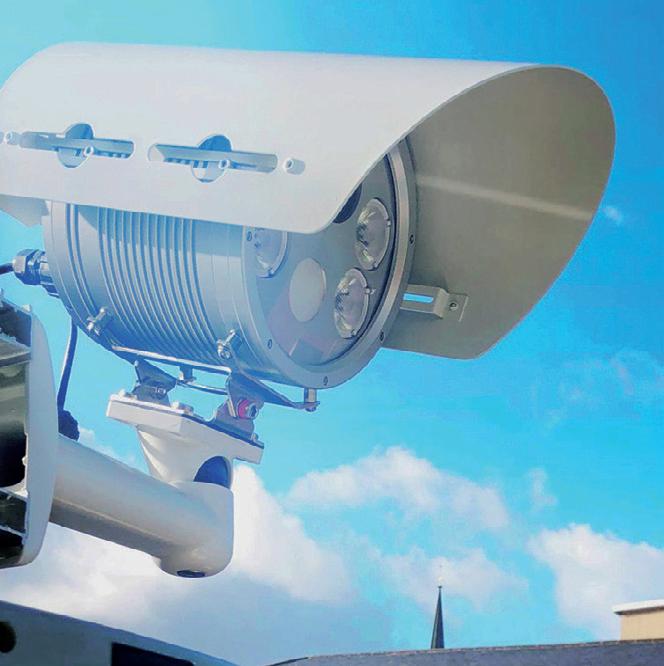












Editorial Managing editor:
Mark Moran
Tel: 020 7091 7871

mark.moran@landor.co.uk
Deputy editor: Deniz Huseyin Tel: 020 7091 7872
deniz.huseyin@landor.co.uk
Editorial director: Peter Stonham
Production and design production@landor.co.uk
Advertising, sponsorship, marketing and exhibition packages

Jason Conboy Tel: 020 7091 7895
jason@landor.co.uk
Christina Pierre Tel: 020 7091 7959 subs@landor.co.uk
Accounts
Irina Cocks Tel: 020 7091 7854 irina.cocks@landor.co.uk



Managing Director
Parking

Review was launched in 1989
2YA Published by: Landor LINKS Ltd, Apollo House, 359 Kennington Lane, London SE11 5QY © Landor LINKS Ltd 2022


Car clubs have key role in helping London meet its climate change goals, says CoMoUK
More than 650,000 households in London could give up their private vehicles and switch to car clubs to meet the city’s climate goals, according to new analysis. Research by Collaborative Mobility UK (CoMoUK) has found this would reduce carbon emissions by 82,000 tonnes a year, helping Mayor of London Sadiq Khan meet the targets set out in his transport strategy.
CoMoUK is the national charity for the public benefit of shared transport such as car, bike and e-scooter share schemes. The charity’s new report, Driving London Forward, highlights that the city is home to 2.7 million private cars, making it the single most dominant transport mode. It warned that this does not fit London’s “self-image” or the Mayor of London’s key aims of ensuring 80% of journeys are made by sustainable modes by 2041, and for London to be a net zero city by 2030.
There are currently 3,482 car club cars shared in London by 623,910 members, up from 300,000 in March 2019. Analysis by CoMoUK, conducted in partnership with consultancy firm Steer, found there are as many as 650,000 households that could give up a privately-owned car. This is based on research of the travel habits of car-owning households in London and the identification of car-owning households where their trip frequencies and characteristics show that they could move from private ownership to car club use.
An additional 21,000 car club vehicles would be needed to meet the demand, but there would be around 300,000 fewer privately owned cars on the roads, including 194,000 vehicles not compliant with the ULEZ (Ultra Low Emission Zone).
CoMoUK said car clubs are a vital component of the mayor’s Transport Strategy to shift away from private car travel, creating a safer and more pleasant environment for walking and cycling and reducing emissions.
In a list of recommendations, the CoMoUK report states that Transport for London (TfL) should promote car clubs as part of a package of alternatives to the private car. It wants TfL to coestablish with London Councils and boroughs the basis of an electric vehicle charging infrastructure that suits the needs of car clubs and gives them preferential access. The charity said boroughs should actively promote car clubs as an alternative to car ownership, freeze parking permit charges for car clubs and shift business trips from private cars to car club vehicles. And it said London boroughs should co-ordinate with car sharing operators on centralised data collection for the city, replacing the existing data sharing between car clubs and boroughs. The report also champions the development of mobility hubs to promote uptake of car clubs, micromobility options and electric vehicles.

Richard Dilks, chief executive of CoMoUK, said: “We have produced this report to define the future potential of car club services in London, and the huge impacts these would have are there for all to see. London has strong ambitions to cut its transport emissions but faces equally strong challenges in doing so.
“Our analysis found 650,000 households in London could give up a privately-owned car, with huge benefits for everyone in the city. As London emerges from the COVID-19 pandemic into a changed world, car clubs and other shared transport options should be a permanent and integrated part of the options the capital takes forward as it continues to make itself a more pleasant, productive and less polluted and congested global city.”
Driving London Forward sets out steps to be taken during 2022.
Transport for London should:
• Promote car clubs as part of package of alternatives to the private car (whether the private car is ULEZ compliant or not)
• Allocate support, including officer time
• Co-establish with London Councils and boroughs the basis of an electric vehicle (EV) charging infrastructure that suits the needs of car clubs and preferably gives them some preferential access to some of that infrastructure
• Use Local Implementation Plan (LIP) processes to collectively plan for growth in car club provision.
London Councils should:
• Co-ordinate development of standardised procurement frameworks by London boroughs
• Co-establish EV charging infrastructure with TfL.
London boroughs should:
• Use car club vehicles for borough business trips
• Actively promote car clubs as an alternative to car ownership.
Car club operators undertake to:
• Increase provision of car clubs in or bordering the ULEZ expansion area
• Provide the very cleanest vehicles possible
• Open up funding from streams such as healthy streets and liveable neighbourhoods
• Revitalise the collection and publication of car ownership levels across London, with targets to reduce these
• Move beyond public transport accessibility levels to define Sustainable Transport Accessibility Levels (STALs).
• Co-ordinate with car sharing operators on a centralised data collection from car club operations for the city, replacing the existing data sharing between car clubs and boroughs
• Freeze parking permit charges for car clubs for a period to reflect on the impacts of recent sharp increases
• Offer discounts on parking permits for EV car club cars.
• Work with boroughs, BIDS and major employers to shift business trips from private cars to car club cars.
Given the mayoral ambition for central London and town centre zeroemission zones by 2025:
TfL, London Councils and London boroughs should:
• Increase funding for and implementation of electric vehicle charging infrastructure that suits the needs of car club users and operators
• Update the mayor’s Transport Strategy to place shared transport including car clubs at the heart of all areas of mayoral, GLA and TfL policy
• Design a package of mobility credits including shared transport options
• Combine this with a programme of mobility hubs spread across the city –hubs would bring public transport option(s), active travel and shared transport option(s) together.
• Significantly reduce or remove permit fees for car club electric vehicles until EVs are mainstream
• Explore options for a more sophisticated and coherent road pricing system for London. This should recognise the role played by shared cars in reducing private car ownership as well as bike and e-scooter share. It would logically bring together the Congestion Charge Zone, Ultra Low Emission Zone, Low Emission Zone and London Lorry Control Scheme
• The mayor should use the new London Plan and all planning powers including the Housing Strategy to create a definition of mobility hubs and create a network of them across the capital . These hubs provide natural homes for EV chargepoints as well as shared bikes and e-bikes, shared e-scooters and citizens’ own bikes
• Include demand for charging from car club EVs in EV infrastructure plans.

Athird of car owners who have joined a car club have got rid of at least one vehicle since joining, with more than two-thirds (68%) of those cars that were disposed of being at least five years old, according to a survey published by Enterprise Rent-a-Car.
The research involved more than 4,000 Enterprise Car Club members across the UK and was carried out by shared transport charity CoMoUK. The study showed that half (51%) of car club users also own a vehicle, but that car club membership gave them access to a range of vehicles to fit different needs, such as a oneoff need for a van to move furniture. Almost half of vehicle owners (43%) say they use a car club because it fits their lifestyle, while around a quarter (23%) needed a back-up or second vehicle in addition to their private car. A similar number (22%) said they joined to save money on motoring costs, while 19% said they wanted to reduce their environmental footprint.
The survey revealed that car club members are increasingly likely to use active travel, a key goal of local authorities: 30% of members said they had reduced their journeys in a private car, 18% said they now walked more, which is higher than the national average, and 10% cycled more often. It highlighted that a quarter (25%) of car club members had already tried an EV and nearly eight out of ten (78%) were happy with the driving and charging experience.
“Encouraging car owners to try a car club could be vital in encouraging the behaviour shift needed to achieve the UK’s decarbonisation targets, as removing older, less fuel-efficient and higher emission cars from the road contributes to reducing CO2 levels and also cutting congestion,” said Dan Gursel, managing director of Enterprise Car Club. “Car club usage among car owners also leads to an uplift in the use of electric vehicles, as well as public transport and active travel. Expanding the number of car club vehicles can help local authorities to reduce the number of miles people travel by car and also the number of vehicles they own. It could be a very useful ally for those local authorities introducing low-emission or Clean Air Zones, especially as renting from a car club is also a cost-effective and convenient way for people to try out EV motoring.
“Car clubs are also helping to increase the use of EVs in the UK. A car club allows people who can’t afford to buy or lease a new electric car to drive one. They also give people who aren’t sure if an EV will suit their lifestyle the opportunity to try one.”
Car clubs help drivers save money while ensuring access to a vehicle. Nearly three-quarters (72%) said that membership of a car club saved them money when compared to owning or leasing their own car, while 62% said that they drove less overall since joining the club. The research highlighted that cars remain a vital transport component for many journeys, with more than half of members (57%) saying that they could use the service to travel to places they would not otherwise be able to access.
Gursel said: “Expanding car club availability in communities across the UK could help to ease the growing cost of living pressure that’s affecting so many people. This is because the cost of fuel is included and users only pay for the number of miles they have driven. The cars come with a fuel card if the driver needs to top up on fuel.”
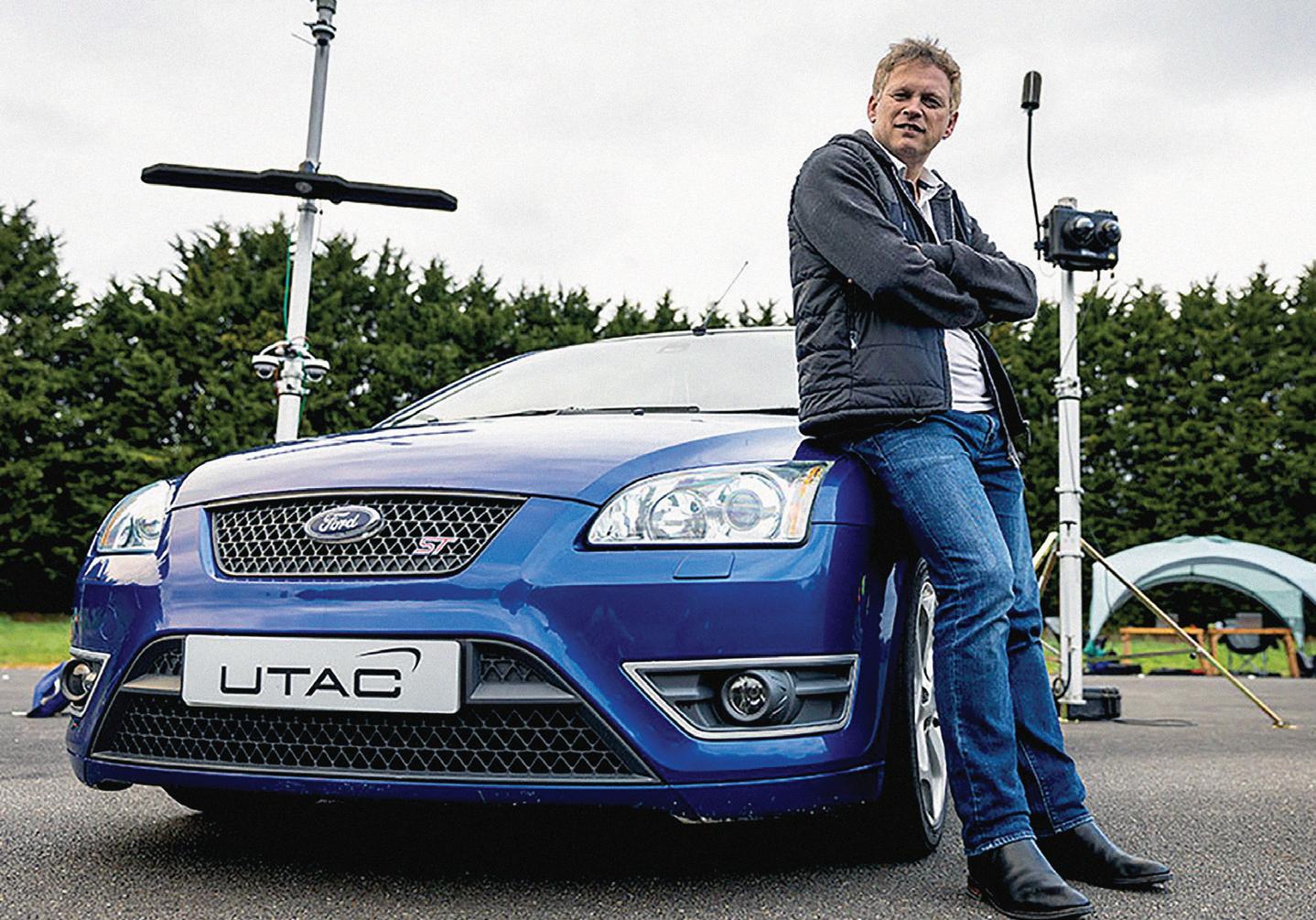
A search for Britain’s noisiest streets has been launched by the Department for Transport (DfT), with four areas across England and Wales set to trial technology to help stop rowdy motorists revving their engines unnecessarily or using illegal exhausts. Since the technology is still in its design phase, MPs are being invited to submit applications to trial new innovative noise cameras in their local area, helping to ensure communities can enjoy their public and residential spaces peacefully.
The technology, backed by £300,000, can automatically detect when vehicles are breaking legal noise requirements, helping provide police and local authorities with the tools and evidence to take action against drivers who flout noise laws.
The latest phase of noise trials builds on a three-year programme to perfect the technology.
The DfT said: “Research shows noise pollution can have significant impacts on physical and mental health for local residents –with heart attacks, high blood pressure, type 2 diabetes and stress all linked to longterm contact with loud environments.
“Excessive noise pollution can mean children struggle to get a good night’s sleep and hardworking people’s lives are made more stressful. In England alone, the annual social cost of urban road noise was estimated to be up to £10bn a decade ago. This is the total economic cost of exposure to noise pollution, including lost productivity from sleep disturbance and health costs from heart attacks, strokes and dementia.”
The government’s Levelling Up white paper stated that complaints about noise are highest among the most economically deprived areas, with those in more disadvantaged areas as much as three times as likely to suffer from noise nuisance. The government has made commitments to ensure that all parts of Britain have the same powers to deal with noise complaints, including providing them with effective tools for tackling incidents that constitute crime and anti-social behaviour.
Transport secretary Grant Shapps said: “We want those in Britain’s noisiest streets, who are kept up at night by unbearable revving engines and noisy exhausts, to come forward with the help of volunteer areas to test and perfect the latest innovative technology. For too long, rowdy drivers have been able to get away with disturbing our communities with illegal noisy vehicles. It’s time we clamp down on this nuisance, banish the boy racer and restore peace and quiet to local streets.”
Police have existing powers, including the ability to issue fines, but currently have trouble gathering evidence.
The technology being used in the trial could provide real-time reports that police can use as evidence and may result in more targeted and efficient enforcement methods to crack down on noisy motorists. The DfT said the technology will be tested in both rural and urban areas.
The trial led by the Atkins-Jacobs Joint Venture, formed by the two professional services firms to provide technical consultancy including acoustics expertise, design, modelling and asset management.

Atkins-Jacobs Joint Venture practice director Andrew Pearce said: “This scheme is a critical development for people living in areas affected by anti-social driving. It
demonstrates how we can use technology to take a highly targeted approach to solving these problems. Testing different noise measurement technologies with a range of vehicles in this controlled environment means we can ensure tickets are only sent to drivers with illegal and antisocial cars or bikes. Highway authorities will be able to automate noise enforcement and get on top of the problem without using up valuable police resources.”
Existing legislation requires exhausts and silencers to be maintained in good working order and not altered so as to increase noise. Under the Road Traffic Act 1988 (Section 42) the potential penalty for noncompliance with these requirements is a £50 on-the-spot fine.
The announcement follows preliminary testing of a prototype noise camera by the DfT in 2019, which showed the technology can identify individual vehicles in certain circumstances and assign noise levels to them.
Noise Abatement Society chief executive Gloria Elliott OBE said: “Excessively noisy vehicles cause unnecessary disturbance, stress and anxiety to many and, in some cases, physical pain. They disrupt the environment and people’s peaceful enjoyment of their homes and public places.”
Motorists should show consideration for local communities and one another when parking at tourist destinations this summer.
‘Be kind – park with others in mind’ is the message of the Selfish Parking campaign created by the British Parking Association (BPA), a membership organisation representing over 750 organisations from across the public and private sectors.
Kelvin Reynolds, BPA director of corporate and public affairs, said: “Communities in visitor destinations are now preparing for another year of managing the increased demand placed on staycation hotspots, including providing additional parking facilities in anticipation of the higher number of motorists. The parking sector, both public and private, believe everyone needs to play their part by only parking where it is legally permitted, helping ensure that streets and communities are kept safe, free from congestion, and can be enjoyed by all.”

‘Please be kind,’ says
DfT wants Britain’s noisiest streets to be test-beds for noise camera technology trialsGrant Shapps models noise detection kit
Additional charges should only be imposed where reasonable and should be waived when overstaying is beyond the driver’s control (such as when treatment takes longer than planned, or when staff are required to work beyond their scheduled shift).
Details of charges, concessions and additional charges should be well publicised including at car park entrances, wherever payment is made and inside the hospital. They should also be included on the hospital website and on patient letters and forms, where appropriate. NHS trusts should publish:
• their parking policy
• their implementation of the NHS car parking principles, including implementation of free parking for those with greatest need
• financial information relating to their car parking
• summarised complaint information on car parking and actions taken in response.
New guidance for NHS trusts sets out which patient, visitor and staff groups should have free parking. The new document sets out how NHS trusts should now provide parking to those in the greatest need. The guidance also offers advice on concessionary fees and states that where parking management is contracted out only reputable companies should be used.
Hospital parking charges for staff were suspended in March 2020 at the start of the COVID-19 pandemic. While parking at NHS sites in Scotland and Wales remains free, parking charges for staff have been reinstated in England. This has led to the Department for Health and Social Care (DHSC) publishing NHS Car Parking Guidance 2022 for NHS Trusts and NHS Foundation Trusts

The current NHS Standard Contract –Service Condition 17.10 – requires that NHS trusts and NHS foundation trusts must comply, where applicable, with NHS car parking guidance.
Trusts are asked to ensure that any car parking facilities at the provider’s premises for service users, visitors and staff are available free of charge to those groups and at those times identified in, and otherwise in accordance with, that guidance.
The definitions of groups who are most in need free parking as follows.
• Disabled people: A disabled person is a holder of a valid Blue Badge attending hospital as a patient or visitor or is a disabled person employed by the hospital trust. Disabled patients and visitors receive free parking for the duration of their attendance at, or visit to, the hospital. Disabled employ-
ees receive free parking while at the hospital for purposes relating to their employment.
• Frequent outpatient attenders: Parking will be provided free to all outpatients who attend hospital for an appointment at least three times within a month and for an overall period of at least three months. A ‘month’ is defined as a period of 30 days.
• Parents of sick children staying overnight: The parent of a child in hospital overnight is a parent or guardian of a child or young person, under 18 years of age, who is admitted as an inpatient at hospital overnight. They receive free parking between the hours of 7.30pm and 8.00am while visiting the child. This would apply to a maximum of two vehicles.
• Staff working night shifts: Staff working night shifts are members of staff with a shift starting after 7.30pm and ending before 8.00am. They receive free parking for the duration of their shift.
A set of principles published in 2015 remain voluntary, but the DHSC said all trusts should implement them wherever possible. NHS organisations should continue to work with their patients and staff, local authorities and public transport providers to make sure that users can get to the site – and park if necessary – as safely, conveniently and economically as possible Charges, where they exist, should be reasonable for the area. Concessions, including free or reduced charges or caps, should be available for visitors with relatives who are gravely ill, or carers of such people, and visitors to relatives who have an extended stay in hospital, or carers of such people in the above groups where appropriate. Other concessions, for example for volunteers or staff who car-share, should be considered locally.
Trusts should also consider installing ‘payon-exit’ or similar schemes so that drivers pay only for the time that they have used.
NHS organisations remain responsible for the actions of private contractors who run car parks on their behalf. NHS organisations should thus act against rogue contractors in line with the relevant codes of practice where applicable.
Contracts should not be let on any basis that incentivises additional charges, for example ‘income from parking charge notices only’.
NHS trusts are advised that there are two trade associations: the British Parking Association and the Independent Parking Committee. NHS organisations should consider imposing a requirement for contractors to be members of such an association.
If the car park operator is a member of either, their relevant code applies and an appeals service is available to motorists. The government has published a Private Parking Code of Practice which organisations are expected to follow, and will come into full force, replacing the current arrangements above, in 2024.
2015 Health Technical Memorandum 0703: NHS car parking management: environment and sustainability provides further advice on providing parking in the NHS.
The DHSC stated: “Each site is different and very few will be able to provide spaces for everyone who needs one. Since 2010, national planning policy no longer imposes maximum parking standards on development, and no longer recommends the use of car parking charges as a demand management measure to discourage car use.”
A ‘reasonable’ implementation of additional charges practice might include additional charges for people who do not have legitimate reasons for parking (for example, commuters), or who persistently flout parking regulations (for example, blocking entrances). A period of grace should normally be applied before a parking charge notice is issued.”
frequency of several existing bus services, as well as a young person’s fare discount.”

Leicester City Council is to press ahead with its ambitious bus partnership plans despite missing out on government funding last month. As part of the National Bus Strategy, the Department for Transport awarded funding to 31 local transport authorities.

Bus Service Improvement Plan (BSIP) bids from England’s other 48 LTAs were unsuccessful, among them Leicester which had hoped to receive £41m. It will now bid for further sources of funding, and hopes to generate revenue from its proposed workplace parking levy scheme.
The council has announced the Leicester Buses Partnership, an eight-year plan, including a three-year programme of fullyfunded transport improvement projects. This will include the electrification of key bus routes, new bus lanes, coordinated timetables, improved passenger
information, ticketing and waiting facilities, and two new park & ride sites.
One of the first Leicester Buses Partnership projects is the “Tap On Tap Off” digital fare system, which automatically enables passengers to get the best fare for the journey they have made, even if they have used more than one bus operator.

The city’s bus operators Arriva, First Bus, Centrebus, Kinchbus, Stagecoach and Roberts Travel
Group
Leicester deputy city mayor for transport and the environment, Cllr Adam Clarke, said: “BSIP funding of £41m would have helped pay towards additional electric buses, new priority bus lanes, additional real-time bus information signs, and another new park & ride site for the city for the improved
Despite this setback, the council is determined to transform public transport in Leicester, said Clarke. “We are currently considering responses to our recent workplace parking levy consultation and will continue seeking and applying for funding as it becomes available.”
The council’s 12-week workplace parking levy consultation closed on 13 March 2022. If taken forward, the levy will require approval by the transport secretary. Workplace parking levy receipts would contribute to delivery of the Leicester Transport Plan projects from 2024 onwards, including the ‘Greenlines’ electric bus network, said the council.
The proposed operating area of the levy would be Leicester City Council’s administrative boundary. A levy charge is yet to be fixed although the council has suggested a cost of around £550 per chargeable parking space per year.
have agreed to work alongside the council over the next eight years to transform the bus network.Hopes pinned on planned charge, reports Deniz HuseyinLeicester Buses Partnership launch
HGV drivers will benefit from £20m to improve roadside facilities as part of government efforts to boost driver welfare and tackle the effects of a driver shortage in the UK.
The funding will go specifically towards improving security, showers and eating facilities as well as exploring increasing parking spaces for lorry drivers. Roadside service operators are being encouraged to apply for the fund immediately.
The funding is part of National Highways’ existing £169m Users and Communities Fund.
The Department for Transport (DfT) said the new funding takes the total government investment in driver facilities to £52.5m since last year.
Some £32.5m was previously committed in the Chancellor’s budget to provide better facilities right across the country for HGV drivers, to drive up standards and further safeguard driver comfort and safety.
Roads minister Baroness Vere said: “HGV drivers play a key role in keeping our nation running and contributing to the economy, and it is vital they feel safe and comfortable wherever they stop. That’s why we’re allocating £20m to ramp up security and improve amenities for drivers – building on the raft of measures we’ve already taken to support the industry.
“We’ll continue to work closely with the sector to boost
even further.”
Nick Harris, National Highways chief executive, said: “We want all road users to reach their destination safely and encourage everyone, from those who drive as a profession through to people travelling on holiday or for leisure purposes, to plan ahead before setting off and to take regular breaks.
“We are dedicated to improving the experience of everyone using our roads and remain committed to working closely with operators of roadside facilities to help improve the standard of parking and other amenities they provide on motorways and major A-roads. We are hopeful that the £20m being announced today will go some way towards achieving this goal.”
Ken McMeikan, chief executive of services operator Moto
announcement is a welcome boost for the UK’s hardworking HGV drivers and the sector. It is encouraging to see that the input provided by Moto and other industry figures have been acknowledged and acted upon by the Department for Transport.

“Moto continually invests in refurbishing and cleaning the services we provide for HGV drivers and has been investing £12.5m in upgrading all our showers and toilet facilities. We look forward to making an application to this £20m fund, which would allow us to accelerate our plans for enhanced security and increase the physical number of showers we can offer.”
The haulage sector welcomed the announcement, with caveats. Mags Simpson, Logistics UK’s head of policy engagement: “The announcement of an additional
ities is a positive step forward for industry. Logistics UK is now calling on roadside service operators to urgently apply for funding. Logistics UK members have previously cited the lack of available lorry parking and suitable roadside facilities as one of the main barriers to recruitment and as a result, an increase in funding for this vital sector of the economy is much welcomed news.
“Lorry drivers are required by law to take regular rest periods, including overnight mandated rest breaks. It is vital that these key workers, who are charged with keeping the nation stocked with all its required goods, have a safe place to take these breaks, where they are also able to make use of much needed bathroom and catering facilities.”
Operation Brock, a traffic management system intended to keep vehicles moving when there is disruption to travel across the English Channel, is leaving HGV drivers stuck without access to food, water or toilets, warns Logistics UK.

Heidi Skinner, policy manager South at Logistics UK, said: “Logistics UK is calling for an urgent review into the effectiveness of Operation Brock as a traffic management scheme, and most importantly, the humanitarian issues it raises as HGV drivers are left unable to access basic hygiene facilities, food and drink; local residents are also left to cope with challenging road diversions and disruption.
“Over the past couple of weeks,
Operation Brock has been implemented for its first period of prolonged use and there are undoubtedly lessons that need to be learned. HGV drivers accessing the Short Straits (the quickest way to get from the UK to the European Continent) have to use
the set route to join the queuing system, and must stop to use facilities before they get too far along the route, as, once their vehicles enter the queueing system, these drivers have no access to any facilities at all, including toilets.
“HGV drivers must be given access to basic welfare facilities while in long queues; this review is needed urgently, and we must consider how our HGV drivers can be better provided for when there are delays in accessing our ports in Kent. In the meantime, we need to see a rapid reinstatement of full ferry capacity before the weekend; this has been the key contributing factor to the traffic queues, along with ferries that were out of action due to damage, bad weather and increased friction at the border caused by the UK’s departure from the EU.”
Roadside services will have better security, lighting and showers
Logistics UK calls for Operation Brock review




























The digitisation of traffic regulation order (TRO) processes in England is moving forward, with the Department for Transport (DfT) publishing the research that is informing its plans.
The DfT is consulting on a new requirement to publish standardised, digital and open data about all TROs for anyone to access. In parallel, views have also been sought on streamlining the process for installing electric vehicle chargepoints.
The department has published research on ways of creating a data platform for TROs. The ‘alpha’ study, undertaken by consultant Valtech, considered whether to create a single digital platform for TROs.
Valtech looked at views and attitudes to adopting a data publication platform, and the design options for this. TRO Data Model Alpha Report sets out the benefits of a digital TRO model and its associated policy changes to enable improvements to current highways authorities and utility traffic operations. Digital TROs would also enable the move to facilitate the DfT’s Future of Mobility strategy.

Valtech reported that an appetite for digital TROs is shared across highway authorities, utilities, data aggregators and service providers currently constrained by the lack of a common standard and associated high-quality, single-source of road closure and restriction information.
The Valtech team recommended five high-level actions:
1. Mandate use of the common data model, making available all TRO data to a central data store architecture. This would include: one single standard digital model that highways authorities are mandated to use for publication and distribution; a definition of the quality and reporting stages of a TRO. This would enable a trusted, consistent, single-source of all TROs.
2. Issue a clear statement of DfT’s short and long-term plans, strategy and approach to supporting highways to digitalise their TROs. This would include: showing that a national initiative should not stop highways changing to digital TROs; showing stakeholders their investment will not be wasted; clarify current rules; provide early sight of the data model; provide a clear statement on dealing with backlogs of TROs;
publish the DfT’s intentions, to be clear to the market and reduce uncertainty. Stakeholders would then have confidence to invest now in digitalising TROs and services.
3. Support stakeholders in understanding and changing to a common data model. This would include: validation of the digital model against further real world TROs; the research scope for links between digital TROs (D-TROs) and Street Manager permits; the DfT supporting data quality and service adoption via training and guidance by developing a D-TRO community. All highways authorities should start to adopt current best practice right away, creating a level playing field, especially for those reluctant to change.
4. DfT to drive data quality. This would include: the digital model data fields that will encourage discrete lists or perameterised templates, with less
People travelling in self-driving cars will be able to watch videos on built-in screens under changes being made to the Highway Code. However, using mobile phones while driving will remain illegal. Drivers will need to be ready to take back control of vehicles when prompted, the Department for Transport (DfT) said.
The changes are expected to come in over the summer. They will state that users of self-driving cars will not be responsible for crashes. It will be insurance companies, not individuals, which will be liable for claims in many circumstances, the DfT said.
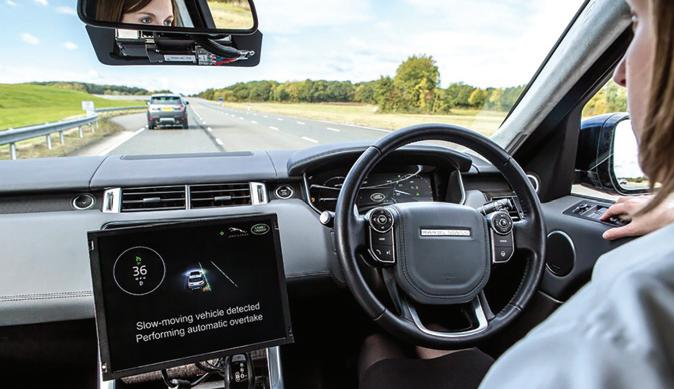
The updates are described as an interim measure to support the early adoption of the technology, with a full regulatory framework to be implemented by 2025.
No self-driving cars are currently allowed on UK roads, but the first vehicles capable of driving themselves could be ready for use later this year. The first use of selfdriving technology is expected to be when cars are travelling at slow speeds on motorways, such as in congested traffic.
The DfT said: “The changes to the code
free text; a commitment to research, define and mandate better temporal and geographic accuracy; publication of location data as coordinates that are agnostic to map type. As an outcome, data quality can improve outcomes for today’s services, emerging connected services and future automated vehicles
5. Use a ‘beta’ project phase to drive delivery of the D-TRO solution and to prove the value to stakeholders. This would mean that wider stakeholder confidence should emerge, and current inertia be overcome by building trust.
The research builds on the 2020 report about TROs and associated data and feeds into the current 2022 consultation proposals for reforms to TROs.
The Valtech report was published alongside a study into the impact of temporary TROs during the COVID-19 pandemic. This evaluation report, conducted by Ipsos Mori on behalf of the DfT, assesses the impact of temporary amendments to the procedures for emergency and non-emergency traffic regulation orders (TROs) during COVID-19.
The period of emergency regulations was between May 2020 and April 2021. The research specifically considers the impacts of: the Traffic Orders Procedure (Coronavirus Amendment) Regulations 2020; and the network management duty guidance.
Both the digital TRO alpha and temporary TRO research fed into the 2022 consultation proposals for reforms to TROs.
will help ensure the first wave of technology will be used safely, explaining clearly that while travelling in self-driving mode, motorists must be ready to resume control in a timely way if they are prompted to – such as when they approach motorway exits.”
The plans will change current regulation to allow drivers to view content that is not related to driving on built-in display screens, while the self-driving vehicle is in control. It will, however, still be illegal to use mobile phones in self-driving mode, given the greater risk handsets pose in distracting drivers, as shown in research.
A public consultation found the majority of respondents were broadly supportive of proposed changes to The Highway Code to clarify drivers’ responsibilities in self-driving vehicles.
Think-tank maps secure bike spaces, reports Deniz Huseyin
There are stark contrasts in the provision of secure cycle parking across the capital, with some boroughs “still favouring less sustainable modes of transport”, states a new report by Londonbased think-tank Fare City.
Big disparities remain in the demand, delivery, and cost of cycle hangar space across London’s 32 boroughs, says the report London’s Cycle Hangars: An assessment of provision in five maps. It states: “It would also appear that other, less sustainable, modes are still being favoured over the cycle.”
The “long-established cycle between car dependency and electoral votes at a local government level must be broken”, according to Fare City. “The extent to which this cycle manifests itself is evident by the inequity of the cost of a cycle hangar space versus that of a car parking space in the majority of London boroughs.”
Boroughs should work to make cycling and sustainable travel “a vote-winning issue”. This will require a strategic vision that “aspires to communicate the equitable, economic, and environmental benefits of cycling
and aligning these with residents’ current and future transport needs”, which would encourage more people to cycle and redress the imbalance between cycle and car parking costs.
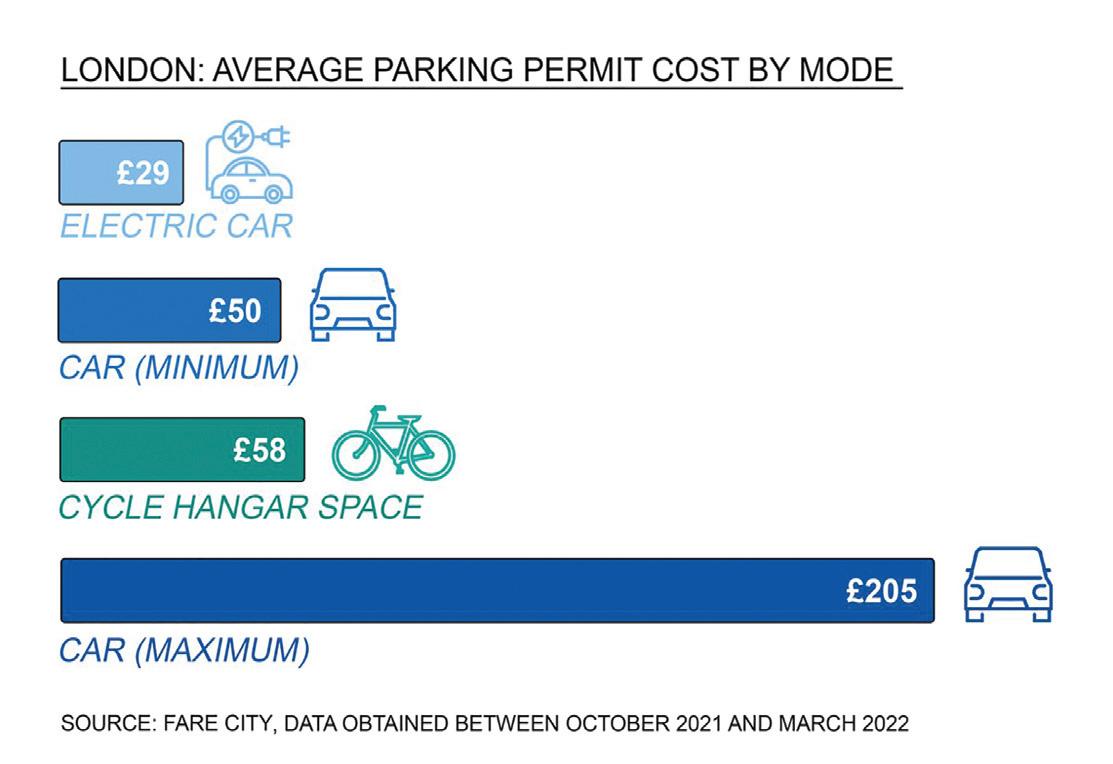
The number of Londoners on a waiting list for a cycle hangar space is nearly three times greater than the current level of provision, the report estimates.
Findings in the report are based on “comprehensive datasets” as well as five interviews with experts and three interviews with public stakeholders.
A range of interdependent factors were identified including the borough’s geography and
level of contested space, as well as the prevalence of car dependency and political expediency.
Officer capacity for implementing cycle hangars varies greatly between London boroughs, the report found. “Some borough officers may manage the delivery of cycle hangars as part of a broad transport-based brief, while another borough’s officers will be tasked exclusively with the delivery of cycle hangars.
“From identifying demand for hangars through to installing them on site, the delivery of hangars can be a time-intensive process that boroughs prioritise to differing extents, based on
The government could allow the sale of electric scooters that can be used on roads in England, transport secretary Grant Shapps has told the House of Commons Transport Committee. Legislation enabling retailers to sell approved e-scooters could be introduced in the Queen’s Speech.
Despite being only legal for use on private land, e-scooters bought by members of the public are currently being used illegally on streets and pavements.
“I want to crack down on the private market and make it illegal to sell e-scooters which don’t meet the regulatory standards which we will bring in,” Shapps told MPs.

There are currently no standards for e-scooters because they are not legally recognised as a form of transport, the transport secretary said. “The first thing to do is to set standards,” he said. How powerful can they be, how fast do they go, do they have indicators, do they have lights at night and so on? And the second thing to do is to hold the retailers accountable. You can make it an offence to sell one which doesn’t fit within the law.”
E-scooters are currently only legal for use
on roads if they are hired as part of government trials that are being operated in around 50 areas across England. The models used in trials have safety features such as speed limits of 15.5mph and automatic lights.
Shapps pointed out that e-scooters are already being used regularly in other countries. “You can’t uninvent technology,” Shapps observed. “We will take powers to properly regulate and then be able to decide the usage of them. They’re a reality, they exist. If these things exist they need to be made safe, and I think the trials have been useful in gathering data and there’s more data still to gather.”
Committee member Simon Jupp MP
their individual trajectories.”
All boroughs should create an officer role dedicated to the delivery of all types of cycle parking spaces, Fare City recommends.
Demand for cycle hangars should also be better managed, it suggests.
“Boroughs with low levels of demand should aim to generate and then nurture sustained levels of higher demand, whereas boroughs with high levels of demand should aim to manage demand more effectively. While installing new hangars to meet demand is preferable, existing hangar provisions could be made to work more efficiently by freeing up underutilised spaces and encouraging active occupancy.”
Fare City recommends that cycle hangar parking needs to be more equitable to the needs of residents. “Currently, annual rental schemes are inflexible and do not incentivise active occupancy.”
A range of rental options – in line with car parking permits –would help boroughs and suppliers more easily track usage to match those on waiting lists to spaces, the report says.
“Furthermore, boroughs and suppliers should commit to serving the needs of those with nonstandard cycles, not only to meet existing demand but also to generate and nurture new demand.”
(Con) raised concerns over the safety of e-scooter, saying there has been 900 collisions, 11 of which were fatal.
Government figures show that there were 931 casualties involving e-scooters in the year to June 2021, but suggest there were just three fatalities. None of the fatalities involved official trials, Shapps said.
Ben Bradshaw MP (Lab) was supportive of e-scooters, which he called a “convenient, cheap and environmentally friendly form of transport”. Bradshaw asked Shapps when the Department for Transport will “get a move on and properly license these things?” Shapps answered: “I shall announce it on 10 May.”
The government is also set to regulate the operation of pedicabs, human-powered vehicles which ply for hire in town centres. Committee chair Huw Merriman MP (Con) asked if the government would commit to do something about unsafe and unlicensed pedicabs.
Shapps responded: “We will bring in this next session a law to control what I think is the Wild West of pedicabs or rickshaws, particularly in London, where there isn’t legislation which accurately enables any type of proper licensing or control.”
Too many vehicles rather than traffic-calming measures is the most likely reason for delays in ambulance and fire engine response times in London, concludes a report by climate action charity Possible.
Its analysis of the 2020 COVID19 lockdowns found that 999 London Ambulance Service average response times to the most serious medical emergencies fell by 47 seconds, and by 2 minutes 39 seconds for serious emergencies where patients were conveyed to hospital.

Data also showed that 999 London Fire Brigade average response times to the most serious fires fell by 40 seconds during the lockdowns.
“Both drops in response times correlate closely with reductions in traffic congestion on London’s roads during these periods,” says the Delayed Response report.
“The traffic-calming measures introduced during the lockdown were accused as being a cause for delays to emergency vehicles. However, research does not support these claims but instead shows that the real problem is excess car use causing traffic and congestion.
“Meanwhile, the chronic problem posed to 999 response times by excess traffic and congestion on London’s roads
remains largely overlooked and unaddressed.”
Each percentage point increase in London’s congestion levels is associated with a one second increase in fire service 999 response times, says the report.
Leo Murray, Possible’s director of innovation, told Parking Review: “There is still no evidence that cycle lanes or LTNs lead to delays in emergency response times. But the living experiment
A High Court decision to reject a legal challenge to Lambeth’s Low Traffic Neighbourhoods (LTNs) has been upheld at the Court of Appeal.
The judgement re-confirmed the High Court’s decision that the London borough had taken due regard of the equalities impacts of the experimental Low Traffic Neighbourhood schemes when it made the decision to implement them. The decision related to traffic orders for three LTNs in Lambeth –the Oval Triangle Low Traffic Neighbourhood, the Streatham Hill Low Traffic Neighbourhood and the Railton and St Matthew’s Low Traffic Neighbourhood.
In June 2021 the High Court dismissed a legal challenge to LTNs. The Court of Appeal examined if, when the council made experimental traffic orders under section 9 of the Road Traffic Regulation Act 1984, it had discharged the “public sector equality duty” under section 149 of the Equality Act 2010. The Court of Appeal agreed with the earlier High Court judgement that the council had done its duty.


The legal challenge was brought by resident Sofia Sheakh, who is
severely disabled and depends on her car for every journey from home. She argued that LTNs had made her life more difficult as displaced traffic increased congestion on local streets, adding to her journey times.
A Lambeth spokesperson said: “The Low Traffic Neighbourhoods that the council has implemented are just one part of our holistic approach to making Lambeth’s roads and neighbourhoods healthier, safer and more equal. The majority of Lambeth residents do not have access to a car and that is particularly the case for many communities which are

disproportionately impacted by collisions or toxic air pollution. Therefore, to make Lambeth a more equal place, we need to enable more journeys to be made by active and sustainable methods and fewer by motor vehicles so those effects lessen. Throughout the trial schemes we have engaged with residents and businesses thoroughly and have changed and improved them off the back of this feedback. We have also introduced dispensations for Blue Badge holders to make it easier for Lambeth residents who are reliant on their cars to get around.”
of London’s COVID-19 lockdown periods, when the streets were entirely free of traffic congestion for the first time in half a century, showed that average 999 response times to the most dangerous fires and medical emergencies would be precious seconds faster – minutes, in some cases – if not for the traffic jams which plague the city every rush hour.”
Those speaking against the “menace of cycle lanes remain curiously silent about the chronic, ubiquitous, daily delays that ambulance and fire crews suffer from the gridlock caused by too many single occupant private cars trying to drive on our streets at the same time,” said Murray.
“We hope the experience of traffic-free, much faster blue light responses during lockdown might offer a chance to reflect on whether the status quo on the roads might be the real problem here – and not the easy scapegoats of a few new cycle lanes.”
Delayed Responses
https://tinyurl.com/3cnteu4u
The Isle of Man will be adopting a tougher approach to the issuing of penalties. The island’s government said it supports the police in addressing parking misdemeanours to improve safety, particularly for vulnerable or disabled pedestrians.
Infrastructure minister Tim Crookall said that although there had been no change to the rules, the police will no longer issue advisory notices for a first offence.
Crookall told the Tynwald, the island’s parliament: “I think for years probably the police have gone out of their way to try and be nice to motorists and left them alone. We have to abide by the law, and if people are seen to be parking in dangerous positions or on the pavement blocking it for pedestrians, then the police or the traffic controllers will act accordingly.”
Concerns were raised by Jason Moorhouse MHK that fines had been handed out inconsistently and that enforcement seemed to just take place in suburban areas.
Survey debunks claim traffic-calming delays emergency services, reports Deniz Huseyin
build specialist HUBER reverses its European supply lines to help war victims
Russia’s invasion of Ukraine has seen organisations, families and individuals across the UK and Europe look for ways to make a positive contribution to the plight of people who have been dislocated and injured in the war.
One parking company has been able to use its European logistics network to send much needed aid to Ukrainian people.
When designing and building multistoreys, HUBER Car Park Systems UK draws on a supply chain that spans Europe. For example, its car park superstructures are produced in the company’s steel manu facturing facility in Poland.
“The HUBER UK management team decided to support the people of Ukraine, while involving the communities and char ities local to our sites in the UK,” said Tomer Meirom, managing director at HUBER Car Park Systems UK.
“It was agreed that donations would be collected at our sites and the transport would be organised to get these donations to the Ukraine: this would basically be a reversal of our usual supply chain. Instead
of transporting goods from Poland to our UK sites, we would transport donations given by the communities local to our sites, as well as our subcontractors, clients and suppliers, to the Ukraine.”
HUBER volunteers and suppliers designed and printed flyers and banners, distributed the flyers, called local organisations, and accepted donations on all construction sites currently run by HUBER, in Dorchester, Cambridge, Elstree, Southampton and Watford.

“We received a variety of donations from food and medicine to nappies and wipes,
warming: children writing little notes and attaching them to toys they had chosen to donate; young families putting together little boxes of nappies and wipes, as they could not afford to give an entire package; and elderly people with memories flooding back of when they had to leave their homes and family.”

The initiative is having a positive effect on the UK communities that are stepping up to help Ukraine, observed Meirom. “An unexpected positive was also that our site teams, when accepting donations, interacted with local people far more than they would have done otherwise,” he said.
“This re-affirmed our belief that the community must be at the heart of every project we do, which we try to reflect with our bespoke designs. For example, both in Dorchester and in Stevenage, our façade shows images chosen by the local community to reflect the local heritage.”
The donations collected on the sites were transported to HUBER’s UK head office in Langley. On 23 April, all the donations were sorted and packed, ready for transport to Lviv in the west of Ukraine.


Meirom said: “On behalf of the Ukrainian people who have received these items, we would like to thank all who assisted us in making this campaign a success.”
Parking technology company WPS Parking Solutions has appointed Thomas Donaldson as business development manager for North of the UK. Donaldson’s role will be to support existing and prospective clients by demonstrating how integrated WPS systems can improve customer experience, automate administrative functions and enhance revenues.

With a background financial services IT, Donaldson believes his know-how will translate well to the increasingly integrated and systems-led
parking sector.
Donaldson said: “My goal is to get out and get talking to as
many businesses as possible and ultimately further WPS’s presence in the North. Building relationships is what I love to do, and I am relishing my new role in being a part of the WPS and helping to make a difference to businesses looking to further their parking operations.”
Simon Jarvis, managing director of WPS, said: “Thomas is very technically minded and has jumped into his role with admirable enthusiasm. We are all thrilled to see that he is hitting the ground running and I am looking forward to seeing how the relationships he is already developing move forward.”


Stephen Edwards has been made chief executive of Living Streets, after nine months as interim CEO.
He joined Living Streets in 2018 after working in a range of roles advising charities, companies and trade associations on their public relations and communications strategies.
During his time as interim CEO, the charity has seen investment in its work in Scotland double; additional funding for its walk to school programme in England; and changes to the Highway Code to put pedestrians at the top of a new road user hierarchy.
APCOA Parking has launched an environmental, social, and governance (ESG) programme called Sustainability in Action.
Kim Challis, currently regional managing director UK & Ireland, is taking on the additional appointment of group director ESG. She will lead what is a group-wide effort based on her longstanding operational experience in this field.
“The increasing urbanisation, digitalisation and new mobility trends are changing the urban ecosystem,” said Challis. “With our digital and physical infrastructure, our innovative operational models, we can make a substantial contribution to a sustainable urban development.
“We have set ourselves ambitious targets that reflect our commitment to our colleagues, customers, clients and suppliers, our communities, and the environment we work in.”
The programme seeks to steer a path towards climate neutrality, a defined social agenda for the employees and the communities the company are operating in. It will create a governance structure that specifies how the company should operate. The measures will follow the UN Global Compact Agreement, which the company has signed.
In a bid to achieve climate neutrality, the company said it
Parking enforcement debt recovery company, DCBL has launched a nationwide recruitment drive to strengthen key teams across the business.
The company has already added over 70 new starters to the team over the last 12 months across its national network of offices and this growth supports the growing demand for its range of effective and compliant debt recovery services.

Following the post-pandemic return to the workplace, the debt recovery firm has invested in its Cheshire headquarters to improve the working environment of its contact centre, collections and legal teams. The offices have been refitted with open plan desks, collaborative breakout areas, and a series of Zoom rooms for improved communications.
DCBL collects debts owed to UK parking operators, using a datadriven approach to support a letter driven debt recovery service.
The firm recently launched a newlook website to increase the effectiveness of its early engagement

strategies, facilitating payments and offering a more effective way to support its clients in identifying vulnerable customers that may require additional support.
Darren Connor, managing director at DCBL, said: “Our successes over the past year signal an exciting new chapter for DCBL and have paved the way for several new opportunities – one of those being the expansion of our dedicated customer support teams. Across our nationwide network of offices, each member of staff understands the importance of delivering an unparalleled level of service to our clients and their customers, and I take pride in how hard they work to achieve the best possible outcome.”
will be switching to 100% renewable energy where possible, accompanied by activities to further reduce energy consumption in car parks.
To help drive the ESG initiative forward, APCOA has partnered with service provider First Climate and is participating in the Climate Group’s EV100 initiative.

APCOA is exchanging its corporate car fleet to full electric
vehicles and is preparing to substantially extend its EV charging infrastructure by adding tens of thousands of charging points over the next few years in its car parks.
Challis said: “Parking activities are at the center of mobility as either a starting or an end point of a journey with a car, bus, motorbike, bicycle, or any other form of individually owned or shared transportation. APCOA is dedicated to contributing to making this ecosystem as sustainable as possible.”
Philippe Op de Beeck, chief executive of APCOA Parking Group, said: “At APCOA, we believe it is our responsibility to grow and develop as a company in innovative, responsible, and sustainable ways. Over many years we have taken a wide variety of measures across the ESG spectrum.
“We are now reinforcing our commitment and have bundled all our sustainability activities in a focussed group-wide ESG programme called APCOA Sustainability in Action.”
We currently supply and have vacancies around the UK for Permanent and Temporary positions:
• Civil Enforcement Officers
• Environmental Enforcement Officers
• Parking Back Office (Appeals/Notice Processing/Correspondence)
• Parking Change Management
• Interim Parking Managers
• Car Park Attendants/Marshalls/Stewarding
• Parking Supervisors (Both Enforcement and Back Office)

• Parking Management (Both Enforcement and Back Office)
• Heads of Parking/Directors
• Parking Technologies (Business Development and Project Managers/ Field Service Engineers/General Managers)
• Off Street Parking (Business Development, Contract Managers and Regional Managers)
• CCTV Operators – SIA and BTEC qualified
Looking for staff or need employment? Please contact our experienced team on:


Tel: 0203 668 5680
Email: parking@unity-recruitment.co.uk
Web: www.unity-recruitment.co.uk


The Enforcement Summit 2022 will explore the latest policy, legislative and operational developments in the field of traffic management, parking operations, air quality schemes and debt recovery.

The event encompasses: local authority enforcement operations; Clean Air Zones, management of parking on private land; and the collection of road traffic, parking and other debts.
Keynote speakers and expert panels will examine themes such as:
n Civil parking enforcement
n Moving traffic regulations
n Clean air schemes
n Road user charging
n Tackling nuisance vehicles and persistent evaders
n The regulation of parking and trespass on car parks and private land
n Balancing education and enforcement to encourage compliance
n Intelligence-led enforcement and debt recovery
n Managing appeals and representations
n Engaging with vulnerable debtors
n The prevention of anti-social behaviour (littering, fly-tipping, noise issues)
n The role of civil enforcement agents in multi-agency operations
n Training the front line and the back office
n The use of ANPR as an enforcement and intelligence tool
n The collection, management and use of data
The Enforcement Summit will provide an opportunity to meet peers, colleagues and other professionals in both structured discussions and at informal networking sessions, including a drinks reception to close the day.
Public Sector Delegates FREE*
Commercial Delegates £245 + VAT

* Conditions apply
ENFORCEMENT SUMMIT 2022 EXHIBITION
Confirmed exhibitors include:
Visitors: The exhibition will enable attendees to check out the latest systems and services on offer to the traffic, parking and air quality management sector.
The Enforcement Summit 2022 provides your company with the perfect opportunity to carefully target the marketing of your products and services to those working in the parking and traffic, clean air and public space sectors.

To participate in this sector-defining event contact: Jason Conboy T: 020 7091 7895 E: Jason@landor.co.uk
www.enforcementsummit.co.uk
















Editorial
Managing editor:
Mark Moran
Tel: 020 7091 7871
mark.moran@landor.co.uk
Production and design
production@landor.co.uk
Advertising, sponsorship, marketing and exhibition packages
Jason Conboy
Tel: 020 7091 7895
jason@landor.co.uk
Subscriptions
Christina Pierre
Tel: 020 7091 7959
subs@landor.co.uk
Accounts
Irina Cocks Tel: 020 7091 7854 irina.cocks@landor.co.uk
Business manager
Rod Fletcher Tel: 0191 280 1410
Printed by: Pensord
Tram Road, Pontllanfraith, Blackwood NP12 2YA
Published by: Landor LINKS Ltd, Apollo House, 359 Kennington Lane, London SE11 5QY
© Landor LINKS Ltd 2022
www.landor.co.uk
Registered members of:



The Independent Press Standards Organisation www.ipso.co.uk
The Professional Publishers Association www.ppa.co.uk

The electric car is moving from rarity and aspiration to the mainstream. TV adverts that not so long ago featured electric concept cars now promote the EV production models that seem to have displaced fossil-fuelled versions in terms of marketing.

How things have changed since 2011, when just nine plug-in car models were available in the UK, accounting for less than 1 in 1,000 total registrations. Today, there are more than 140 plug-in models available, accounting for 1-in-5 new cars sold this year.
There are also growing opportunities to see this ever expanding range of models up close. Beyond showrooms, there are a number of EV festivals such as Fully Charged LIVE, which was held at the Farnborough International Exhibition Centre between 29 April and 1 May. A spin-off from the popular Fully Charged online EV channel, the event showcased more than 100 electric cars, commercial vehicles, motorcycles and mopeds, bicycles, trikes, scooters, skateboards, classics and concepts. It attracted over 20,000 people looking to make the shift to clean mobility and more sustainable lifestyles. International editions will be taking place throughout 2022.
Next up in Britain is the Simply Electric show, which returns to the grounds of the National Motor Museum at Beaulieu in Hampshire on 29 May. This year’s rally is an opportunity for existing electric vehicle owners to connect with other enthusiasts, and prospective EV drivers to compare cars as part of a busy motoringthemed day out. And the petrol and diesel cars are safely displayed in the museum, which is where they belong.
Mark Moran Editor
UK has 30,290 public EV chargepoints, DfT data reveals
The number of public electric vehicle charging devices continues to grow, reveals latest statistical bulletin from the Department for Transport (DfT). The total number of chargepoints available to the public has increased by a third over the past year. As of the beginning of April 2022 there were 30,290 public electric vehicle charging devices available in the UK, of which 5,494 were rapid units.
Since 1 April 2021, the number of public devices has increased by 33%, corresponding to 7,500 devices. The number of rapid devices increased by 29%, with an additional 1,235 public devices.
When compared to 1 January 2022 the number of available devices increased by 1,915, up 7%. Over the same period the number of rapid devices increased by 338, again an increase of 7%.
There was an increase in total and rapid devices across all regions of the UK, reports the DfT. However, there is an uneven geographical distribution of charging devices within the UK.
“Some UK local authorities have bid for UK government funding for charging devices, and others have not,” notes the department. “Most of the
Rapid charging devices per 100,000 population:1 April 2022
provision of this infrastructure has been market-led, with individual charging networks and other businesses (such as hotels) choosing where to install devices.”
London and Scotland had the highest level of charging provision per 100,000 of population, with 111 and 54 devices per 100,000 respectively. In comparison, the average provision in the UK was 45 per 100,000.
Northern Ireland had the lowest level of charging device provision in the UK, with 18 devices per 100,000, followed by the North West and Yorkshire and the Humber with 26 and 27 devices per 100,000 respectively.
Scotland had the highest rate of rapid device provision of 13.6 rapid devices per 100,000, whilst the average provision in the UK was 8.2 per 100,000. Rapid device provision was lowest for

Source: DfT
Northern Ireland and Wales, with 1.3 and 5.8 rapid devices per 100,000 respectively.
An interactive map of this data is available online.
All regions across the UK saw an increase in total charging devices between January and March 2022. London had the greatest increase at 9.4%, whilst Northern Ireland and the North West had the smallest increases at 0.9% and 3.7% respectively.
London also had the greatest increase in absolute number of devices at 863 devices, contributing to 45% of the increase in devices across the UK in this period.
Rapid charging devices have increased in every region in the UK. The smallest percentage increase in the number of rapid devices was in London at 1.9%. Northern Ireland had the largest percentage increase in rapid
The UK government has published an online toolkit offering advice to local authorities on planning and taking measures to reduce carbon emissions from transport.
TheTransport Decarbonisation Plan recognised the role local areas and regions have in reducing emissions from transport.As part of the plan the Department forTransport (DfT) committed to support this work by publishing a toolkit for local authorities.
The toolkit,which has been developed in partnership with Energy SavingTrust,covers themes such as zero-emission buses,active travel,car clubs,freight and rural transport.
The online collection seeks to assist local
authorities by:highlighting the benefits of different interventions;setting out the actions local authorities can take to reduce carbon emissions; sharing best practice and lessons learnt from case studies of successful schemes already delivering local benefits;and signposting local authorities to other published guidance and methodologies
In parallel,a range of advice for local authorities on electric vehicle charging infrastructure has also been published.
The DfT said:“The toolkit is one example of how we are supporting local authorities to decarbonise transport.We will also make quantifiable carbon reductions a fundamental part of local transport planning and funding and are currently updating
devices at 13.6%, corresponding to an increase of three rapid devices.
“The number of available devices can fluctuate for a range of reasons,” writes the department. “Increases likely reflect the installation of new devices, whilst owners and operators can choose to temporarily or permanently decommission or replace devices. Charging devices can also be unavailable due to faults, maintenance or other restrictions in the area where they are located.”
The charging device location data is sourced from the electric vehicle charging platform Zap-Map and represents devices reported as operational at midnight on 1 April 2022. Zap-Map reports that it covers 95% of publicly accessible devices.
The DfT said: “True counts are likely to be higher and it has no way of assessing whether data coverage is better in some geographical areas than others. There are no other sources with such comprehensive coverage against which we could verify the Zap-Map devices.
“As of 11 April 2022, the National Chargepoint Registry (NCR) covers 20,916 devices so cannot be used to verify the Zap-Map counts. The NCR, whilst covering fewer devices, does contain more detailed information on each charging device including the exact location and number of connectors.”
our guidance on local transport plans to help local authorities do this.We plan to publish the new guidance,along with technical advice on quantifying carbon in this context later in 2022.”
The local authority toolkit comprises guidance notes on these themes:
travel
Car clubs
Decarbonising road freight,servicing and deliveries • Demand responsive transport
sharing •Transport in rural areas • Zero-emission buses • Zero-emission fleets.
Residents in County Durham can now hire an electric vehicle for the day, as part of a new car club service. The county council has been working with Derwent Valley Car Club to help it launch the service in Shotley Bridge. The car club has three fully electric cars available to borrow, which residents can hire for an hour up to a full day. It costs £5 a month to join the scheme and the hire rate is £4 per hour for the first three hours, then £3 for every hour after that, or £30 to hire the car for a day. There is no geographical limit as to who can join the scheme.
Croydon Council is on track to meet the target set out in its Climate Action Plan of installing at least 400 chargepoints by the end of 2022. Three months into the year, the council has 152 chargepoints, over a third of its target, already live.
The latest on-street tranche, installed, operated and maintained by Liberty Charge, includes 44 rapid chargepoints. It is a part of the governmentfunded Virgin Park and Charge (VPACH) scheme.
Locations of on-street charging points were driven by resident requests, supported by Liberty Charge’s own data that informs on factors such as density of EV ownership, site pavement widths and the technical elements of onstreet installation.
The City of Edinburgh Council is introducing tariffs for using its electric vehicle chargers from 1 May. The fees, which will be displayed at existing charging points, were agreed as part of the budget-setting process earlier this year. Any revenue generated will be used to fund the ongoing costs associated with electric vehicle charging infrastructure. In March the council began work to introduce 81 chargers (141 bays) in residential streets and park & ride sites. They will be available for use by summer.
Volvo Cars is integrating and testing wireless charging technology in a live city environment, evaluating its potential for future electric cars.
Over a three-year period, a small fleet of fully electric Volvo XC40 Recharge cars will be used as taxis by Cabonline, a taxi operator in the Nordic region, and charged wirelessly at stations in Gothenburg, Sweden.

The wireless charging test is one of many projects outlined within the strategic initiative Gothenburg Green City Zone, under which designated areas within the city are used as live test beds for the development of sustainable technologies.
“Gothenburg Green City Zone lets us try exciting new technologies in a real environment and evaluate them over time for a potential future broader introduction,” said Mats Moberg, head of research and development at Volvo Cars.
“Testing new charging technologies together with
selected partners is a good way to evaluate alternative charging options for our future cars.”
The charging stations used in the test are delivered by Momentum Dynamics, a leading provider of wireless electric charging systems. The charging starts automatically when a compatible vehicle parks over a charging pad embedded in the street, allowing drivers to conveniently charge without getting out of their car.
The charging station sends energy through the charging pad, which is picked up by a receiver unit in the car. To
easily align the car with the charging pad, Volvo Cars will use its 360-degree camera system. For the fully electric XC40 Recharge cars, the wireless charging power will be more than 40kW, making the charging speeds around four times faster than a wired 11kW AC charger and almost as fast as a wired 50kW DC fast charger.
In total, the Volvo cars will be used for more than 12 hours a day and drive 100,000km per year, which also makes this the first durability test of fully electric Volvo cars in a commercial usage scenario.
Renewable energy brand Egg has launched a subscriptionbased charging service that will enable EV drivers to charge their cars at home for £30 per month.
The monthly fee includes standard installation of a home charging unit and free maintenance call-outs within two working days.
Installation will require access to off-street parking such as a driveway or garage.
The launch comes as the government’s Electric Vehicle Homecharge Scheme (EVHS) draws to a close for many homeowners on 31 March.
The EVHS grant contributed up to 75% of the cost of installing a home chargepoint, capped at £350. Without EVHS, the average
cost of hardware and installation for a fast home chargepoint is estimated to be in excess of £1,000, according to independent EV charging comparison site www.RightCharge.co.uk.
“The reality of buying an electric vehicle is that it involves a lot of research and a considerable upfront cost. EVs are an unknown entity to most
drivers and the second-hand market is presently very small, though growing,” says Egg chief executive Thomas Newby. “Installing a home chargepoint should be the most painless part of the process. Egg’s proposition is simple – one affordable, monthly cost that keeps your car moving and offers complete peace of mind.”

The company said paying monthly offers flexibility for customers, especially those who might be considering a house move, or company car drivers who are personally responsible for the cost of installing a home charger if opting for an EV.
The 7kW fast chargers are designed to be compatible with all makes of EV.
Gothenburg taxis will act as test-bedsVolvo XC40 Recharge taxis in Gothenburg Thomas Newby
Electric vehicle charging network operator Gridserve has opened an Electric Forecourt with 36 chargers in Norwich. The forecourt is located at Broadland Gate Business Park in Postwick. It hosts 22 high-power chargers with up to 350kW of power, eight Tesla Superchargers and six low power AC chargers to cater for every type of EV.
The Electric Forecourt is designed to be an EV experience destination, where visitors without electric cars can find out more about them, and chat with impartial ‘EV Gurus’ about charging or vehicle leasing options, whilst enjoying well-known brands including Costa Coffee, M&S Food and WHSmith, along with super-fast Wi-Fi and bookable meeting pods.
The Norwich Electric Forecourt more than doubles the number of high-powered chargers in the region.
Norwich and the wider East of England region currently have comparatively low EV charger coverage compared to other regions in the UK, hosting just 29 chargers per 100,000 people compared to the UK average of 42 per 100,000 people, or 102 per 100,000 people in London. The immediate 10km radius area also has over 40,000 households with no access to off-street parking to accommodate home charging. The result is that currently EVs only account for 1% of cars on the road in the
Norwich area. In addition, Norwich has received government funding to assess the viability of a zeroemission zone in the city in a bid to cut air pollution from the city centre. If the plan goes ahead, all petrol and diesel vehicles could be banned from the city, making emission free electric vehicles essential.
Gridserve said the facility will help EV drivers to access the city centre and improve connections to surrounding areas such as Ipswich, Cambridge and Peterborough.

MSA locations, with more to follow at existing and proposed new MSA developments.
The IONITY charging stations are geographically spread from Cullompton in the South, to Leeds Skelton Lake in the North.
Andrew Long, chief executive of Extra MSA Group, said:“Technology is rapidly advancing and Extra MSA Group is delighted to be embracing this, working in conjunction with IONITY, which is successfully delivering some of the highest-powered charging stations on the motorway network.
“At Extra MSA Group, we are committed to providing all road users with a safe environment to take a break from their journeys, rest and refuel in high quality, comfortable facilities. Our work with IONITY further enhances these overall objectives.”
The Norwich Electric Forecourt showcases electric motoring. Test drives of electric cars can be booked via its EV experience centre.
Toddington Harper, chief executive of Gridserve, said: “Giving drivers the confidence to switch to an electric vehicle and enabling a widespread transition away from fossil fuel vehicles is a central aim of our Electric Forecourts. That’s why we have put the consumer at the heart of our design, with our Electric Forecourts serving the needs of local communities in their transition to electric vehicles.
“The Norwich Electric Forecourt showcases a brand new design, where we have been able to provide both charging and a great customer experience in a smaller footprint than our first site at Braintree. By elevating the facilities above the chargers, we make the best use of the space available and are able to deliver a great EV experience without compromise, even when space is at a premium and sites are more constrained.”
EV in the time it takes them to enjoy a cup of coffee at the Extra facilities.
“Serving up to 350kW charging capacity, our chargers work rapidly using 100% renewable energy –making for not only emission-free but carbon neutral driving and the installation of these in a network that connects drivers right across the country will make for a future of reliable journeys and quick stops for sustainable vehicles.”
All electricity supplied is from 100% renewable sources to achieve high environmental standards. All of Extra MSA Group’s locations also have the capacity to increase the number of EV charging points as customer demand increases.
Extra MSA Group has partnered with the IONITY charging network to launch high-power charging stations for electric vehicles at all its motorway service areas (MSAs) across the UK.

The network will help ensure that Extra MSA customers can access ultrafast charging points when undertaking
long-distance journeys.
IONITY is on track to deliver six highpowered chargers at each site ahead of the UK government’s 2023 target. IONITY and Extra MSA Group have already installed 38 charging points with a high-speed charging capacity of up to 350kW across all eight of its
Andreas Atkins, country manager UK & Ireland at IONITY, added:“IONITY’s continued partnership with Extra MSA Group demonstrates our commitment to drive forward the transition to electric mobility. Our state-of-the-art high-power charging technology will enable drivers to travel hassle-free across the country and charge their
IONITY builds and operates a highpower charging (HPC) network along Europe’s highways, using state-of-theart technology with a charging capacity of up to 350 kW.
IONITY was founded in 2017 and is a joint venture by BMW Group, Mercedes Benz AG, Ford Motor Company, Hyundai Motor Group and the Volkswagen Group with Audi and Porsche.The company is headquartered in Munich with an additional office in Oslo, Norway.
Some groups risk being unfairly excluded from the transition to electrified transport and are calling for proactive measures to deliver an inclusive net zero, warns a report by Scottish and Southern Electricity Networks (SSEN) Distribution.
SSEN welcomes the government’s recognition of the need to ensure chargepoints are inclusively designed and its commitment to publish standards for charging infrastructure by summer 2022. However, an inclusive transition to net zero must ensure a wide range of physical and mental abilities are considered to avoid excluding some groups of people from the transition to EVs.
The Equal EV report, produced for SSEN by the Energy Systems Catapult,
maps out customer journeys for people with disabilities and vulnerabilities such as high levels of anxiety, which is experienced by an estimated 6.6% of UK adults in any given week.
The customer journeys cover the stages of switching to an EV:
• acquisition (contemplation, investigation, and decision)
• familiarisation
• charging at home
• charging away from home
• smart charging
• making long journeys.
People with mobility impairments were most likely to highlight pain points around acquiring an EV and using public chargepoints. People with high levels of
anxiety identified pain points at all stages of the customer journey, including concerns around making a long journey.
The second stage of the Equal EV project examined the viability of technology to remove those barriers and proposed measures to tackle the issues. It also identified potential roles for electricity distribution network operators (DNOs), like SSEN.
Mat Campbell-Hill, former Team GB athlete and interviewee for Equal EV project said: “We need the infrastructure in place to support the take-up of electric vehicles. As it stands, the infrastructure being built ignores the accessibility needs of the general population.
“People with mobility issues may have disabilities, like me, but include anyone

with children, with shopping, who is pregnant, or who has injured themselves. Sufficient space around the vehicles, dropped curbs and well-designed charging cables can benefit everyone and would help make the transition to clean, green transport a real option for everybody. The default for public EV chargepoints should be that every point is accessible unless there is a powerful reason why it cannot be. We have to get this right first time.”
To mark publication of the Equal EV report, SSEN has published videos featuring interviews with drivers who have disabilities and a strong interest in EVs. The drivers give powerful examples of the challenges they face and how the current public EV charging infrastructure is failing people like them.



The Equal EV project was the first time a DNO in the UK had examined barriers and challenges faced by motorists with disabilities and vulnerabilities in transitioning to EVs.

Building on this project, SSEN will be working with Disabled Motoring UK to continue to raise and address the issues
faced by drivers and ensure a fair transition to electrified transport. Sales of EVs are increasing rapidly in the UK, totalling nearly 18% of all vehicle sales in the UK in March. Public chargepoint provision is also increasing and the government anticipates a tenfold increase by 2030 (with over 30,000 installed today). While these changes are welcome the potential difficulties faced by key groups of people when considering adopting an EV have received relatively little consideration to date.
Lisa Doogan, head of customer service and stakeholder strategy at SSEN said: “This essential project has given us vital insights into how we can help ensure that the transition to electrified transport is smart and fair for all our 3.8m customers. We do not believe that groups of people should be excluded from new technology or services because their needs are different. Our reports and interviews with people who have mobility and mental health issues shows there is a lot that can be done to ensure the net zero future can be shared by everyone.”
Video interviews were held with three disabled people who shared their experiences
Mat, who has been an EV driver since 2018 and was a Team GB athlete in wheelchair fencing. He said: ‘Ensuring public EV chargepoints are accessible will benefit people with disabilities, but equally will help anyone with their hands full when holding a baby or holding shopping. If you improve accessibility for one group, you improve it for everyone.”
Nigel, who is an EV driver found that “it does just come down to the fact that there aren’t enough charging points,” and many are poorly designed.
“On my own, on a number of occasions I have found that the charger is completely inaccessible to somebody in a wheelchair and without the kindness of strangers, I would have been completely stuck.”
Simone, who is considering switching to an EV, said: “Some of the concerns I have when it comes to charging an electric vehicle is the dexterity needed to plug in the charging cable. Those things are convenient for most people... but I am not most people.”






Zap-Map EV Charging Survey reveals latest
There has been a marked increase in the use of ultra-rapid chargers across the UK, which indicates both a willingness by electric vehicle owners to drive further and a better distribution of the more powerful terminals across the UK. The increasing popularity of ultrarapid chargers is one of the findings of the annual Zap-Map EV Charging Survey, which provides insight into the experience of 3,000 EV drivers across the UK.
The survey reveals changes in driver behaviour, most notably in the area of high-powered, en route charging and the increasing popularity of charging hubs.
The annual study also reveals high levels of satisfaction among EV drivers, who are increasingly confident about driving long distances, with less than 1% wanting to go back to petrol or diesel.
Zap-Map has also published a top 18 ranking of charging networks based on driver satisfaction, with the top three networks being InstaVolt, MFG EV Power and Osprey.
The new report presents the results from the survey conducted in 2021 together with findings from previous annual surveys in 2017-2020. The results confirm that the vast majority of EV drivers (93%) use the UK’s public charging networks, with 40% using public chargers at least once a week.
There had been significant increase in both the installation and usage of highpowered – also known as ultra-rapid –charging devices across the country in 2021. While rapid chargers (25kW –99kW) are still used by the most EV drivers overall, the survey found that the usage of ultra-rapid chargers jumped to 27% of EV drivers – up from just 16% in the previous survey.

In part, the increase in usage is being driven by the growing number of ultrarapid chargers that are now available to use, with the number of ultra-rapid devices available growing by 60% in 2021. However, Zap-Map believes it also provides an indication that the new ultrarapids are fulfilling demand from EV drivers travelling longer distances, with most new EVs now able to charge at the higher speed.
Ultra-rapid 100kW+ devices are prime examples of en route charging, which is when drivers want to charge their EV as
EV Network Rank Rating Rank
InstaVolt 1 4.4 2
MFG EV Power 2 4.2 n/a
Osprey 3 4.0 3
Pod Point 4 3.8 4
Gridserve Electric Highway =5 3.6 n/a Shell Recharge =5 3.6 6 NewMotion =7 3.5 8
IONITY =7 3.5 10 Ubitricity 9 3.4 n/a Swarco E.connect 10 3.3 5 GeniePoint 11 3.1 12
ESB Energy 12 3.0 7
ChargePlace Scotland 13 2.9 9
Source London 14 2.7 14
EV Charge Online 15 2.6 n/a bp pulse 16 2.5 13
ChargeYour Car 17 2.4 15 Ecotricity Electric Highway (legacy) 18 2.0 16
Note: Tesla was removed from the rankings because its Superchargers are only available to Tesla drivers
Source:Zap-Map
quickly as possible. Zap-Map said that for this reason, and because drivers want to be confident that such devices will be available to use upon arrival, another trend that the survey highlights is the growth in popularity of EV charging hubs.
Typically groups of between four and ten charging devices, hubs predominantly sport rapid or ultra-rapid devices that
enable drivers to add between 70 and 200 miles of charge in around 30 minutes. The survey found that networks installing charging hubs saw particularly high increases in demand from EV drivers.
InstaVolt, for example, leapt up to 42% of EV drivers – from 26% previously. The Gridserve Electric Highway, at 29%, proved popular for its first year, while high-powered networks IONITY and Osprey saw increases in use.
While charging hubs demonstrated the most growth in terms of usage, supermarkets and motorway service areas retained the top two positions, with 52% and 50% of respondents respectively saying they regularly used these types of location. Indeed, supermarkets have seen a significant increase in chargepoints being installed, and chargepoints at motorway service areas have seen charging facilities being upgraded over the last year by Gridserve. In addition, both retail and public car parks remain popular locations for charging, although usage has dipped in the last year.
Melanie Shufflebotham, co-founder and chief executive of Gridserve, said: “As the number of EV drivers on the road approaches half-a-million, a robust charging infrastructure is essential, and the public charging network is growing and developing to meet these changing needs. This new survey shows that the 60% growth in high speed ultra-rapid chargers and the installation of charging hubs across the UK in 2021 are being used by an increasing proportion of EV drivers. We know that EV charging use cases are diverse, as the survey makes clear, and we absolutely need a range of charge speeds to match them. However, amongst other considerations, the demand for highpowered chargers revealed in this report indicates that ultra-rapid chargers and charging hubs continue to be a crucial area of investment – for the simple fact that they make long journeys easier.”
Ultra-rapid chargers and hubs are a crucial area of investment
What types of public charging points do you use?
Sevadis, a supplier of electric vehicle charging products in the UK, is working with chargepoint management system Fuuse to offer a full turnkey solution for commercial customers and fleets.
Sevadis’ customers can now manage their entire EV network with Fuuse, regardless of number of chargers or sites. Businesses can manage payments and tariffs, opening hours and driver access whilst monitoring the status and performance of their chargers. Meanwhile, installers can manage and monitor their entire EV charging portfolios.
Installers could benefit from recurring revenues with Fuuse’s white labelled back office solution, plus features like remote click-to-fix maintenance and comprehensive charging
insights providing additional service opportunities.
The companies are both OCPP (open chargepoint protocol) compliant, meaning there is compatibility and interoperability between their hardware and software.
The integration means client businesses will have access to an end-to-end service spanning project conception to completion and beyond. They will also have full control and visibility over their
British electric car charging specialist EZ-Charge is to ramp-up production of its selfdeveloped 22kWh charging unit. The Oxfordshire-based start-up reports an upsurge in enquiries following the announcement of the government’s new Electric Vehicle Infrastructure Strategy.
EZ-Charge’s range encompasses home chargers to 50kWh rapids. The company expects a lot of interest will be shown by local authorities in its 22kWh model that accepts contactless payment.

EZ-Charge founder and chief executive Phil Shadbolt OBE said: “We were thrilled when the government announced its new strategy and even happier when we realised that the charger features demanded by the new

legislation had been built into our chargers as ‘must-haves’ from the very beginning.
“However, we were not expecting the announcement to translate into actual interest from potential customers quite so quickly. We’ve literally been overwhelmed and we’ve had to go back to the drawing board to dramatically revise our production schedule upwards.”
charging network.
Craig Slater, managing director of Sevadis, said: “Installers play an often overseen pivotal role in the EV revolution, which is why we’re partnering with Fuuse to encourage current and next generation chargepoint installers to grow their businesses whilst pushing EV rollout forward.
“Our entire range of EV charging points are OCPP compliant, so to collaborate
with Fuuse provides both parties as well as our customers with significant opportunities as the demand for EV charging increases over time. We’re delighted to be offering the opportunity for our customers to benefit from the complete flexibility the system facilitates including public billing and intelligent insights, as well as upcoming innovations of fleet smart charging, dynamic load balancing, reservations and true charger status alerts with occupancy sensors.”
Michael Gibson, chief executive of Fuuse, said: “Sevadis echoes our own belief that the installer community are integral to pushing EV roll out forward. Together we’ll be helping businesses transition their own fleets: balancing their entire fleets’ charging needs with those of the grid and their site(s) as a whole. In addition we’ll be responding to the increasing demand for public infrastructure needs from local authorities, destinations and retailers.”
European electric vehicle drivers will be able to use their existing apps and payment cards when in the UK following a roaming agreement being signed between GreenFlux and the Osprey Charging Network.
Osprey has become among the first UK networks to open its chargers at this scale to drivers from mainland Europe. Osprey operates more than 300 fast chargers in over 180 locations. The network spans across the entire country, from Cornwall in the southwest to Perthshire in Scotland. Osprey’s charging stations are colocated with food and beverage and retail venues in towns and along major motorways and A-roads.
GreenFlux is a provider of EV charging software and services used by nearly 90,000 EV drivers in Europe. As part of the roaming agreement, drivers served by each of GreenFlux’s EMSP customers can seamlessly access all 300 chargers, and Osprey’s future chargepoints (set to double in 2022), using their
usual apps and charge cards.
“One of Osprey’s core values is inclusivity for all drivers, and part of the way we achieve this is through being an open-access network. We believe by facilitating roaming with like-minded partners such as GreenFlux we can play a leading role in the electrification of transport – by giving fleet operators, companies who cross borders, and long-distance drivers, a chargepoint network they can rely on away from home,” says Dora Clarke, head of marketing and communications at Osprey. “Opening up our charging points to European drivers on this scale with GreenFlux is a UK-first.”
Dan Pezim, product manager billing and roaming at GreenFlux, said: “The partnership with Osprey is the latest in a series of international connections, and an important step towards increasing our roaming coverage in the UK. With this agreement, we enhance the value provided to our platform customers, and help make EV charging more convenient for drivers.”
GreenFlux and Osprey establish roaming connection for European drivers in UK
Vehicle charging solutions provider CTEK has expanded its UK energy and facilities (E&F) team, which provides training, maintenance, sales, marketing and technical support for car park and chargepoint operators.
CTEK has also partnered with West Midlands-based Rotronics Battery Management Solutions to provide a dedicated UK fulfilment operation. Rotronics is providing a warehousing facility, processing orders, configuring CTEK’s Chargestorm Connected 2 EV chargers to customers’ specifications and managing UK distribution.


CTEK’s EV charging team has expanded with two new sales managers, Mohammed Shi Hub and Nathan Courts, dedicated to chargepoint operators, car park operators and property owners, along with Kaya Ferdinand, covering large chargepoint operators.
Ian Beattie and Adrian Hopkinson have joined the team to cover electrical wholesale customers and
installers. CTEK also recently expanded its aftermarket team with the appointment of Mark Poole.


CTEK’s dedicated Skillbase team – comprising Vicktors Nikolajevs, Tony Zeal and Sean Reed – provides external and in-house training on CTEK’s EV products and solutions.
Technical support and expertise is provided by CTEK’s Jack Baker, working closely with CTEK’s support alliances and partnerships manager, Stewart Allen. Marketing activities are led by Katharine Parker.
Cecilia Routledge, global director energy and facilities for CTEK, said: “We have expanded our UK team to provide unrivalled expertise, training, sales and technical support in the field of EV technology. We are also partnering with Rotronics to ensure that we can meet growing customer demand for EV solutions quickly and efficiently.
“The UK is a core market for us, and our 12-strong UK team
is here to support chargepoint and car park operators with the development of robust, reliable EV charging installations, which is a vital component in the development of sustainable transport to meet the UK’s environmental goals, as we head along the ‘Road to Zero’.
“Central to CTEK’s proposal is that we don’t just sell wall boxes – we are focussed on working with installers to develop complete, futureproofed EV solutions including software applications, load balancing and remote, online system management.
“Our team is here to work with installers right through the process. This includes helping to scope and plan the project based on customers’ needs and expectations, advice on the government grants available, choosing the right charger, integration with customers’ existing systems and equipment, assistance during the commissioning process and full technical after sales support.”
Payments technology company Paythru has appointed Sara Sloman as director of future fleet. She joins the company from Elmtronics, where she held the role of head of future mobility partnerships. “A key part of my role will be to ensure we are putting the user experience at the heart of smart mobility infrastructure,” she said. “The first hurdle is always getting the right chargers in the right place, but now it is also about establishing the behind-the-scenes interface between the multiple parties that will underpin the success of our transition away from internal combustion engines.”
Portable EV charging technology developer ZipCharge has formed a product advisory board whose first member is US-based electric vehicle and charging expert Tom Moloughney. The advisory board will focus on providing development feedback for the ZipCharge Go portable EV charger, future products and software services.The board will initially comprise four EV ‘superusers’ from key global EV markets who possess an knowledge of EV charging and smart energy management.

Sloman becomes Paythru’s director of future fleet
Moloughney advises ZipCharge
ZipCharge used Earth Day to reveal the GoHub, an infrastructure that makes the company’s portable electric vehicle chargers available for shared public use. The GoHub is designed to provide a community-based solution that can be installed at a much lower cost and at a much faster rate than fixed chargers, enabling any parking space to be a charging spot.
ZipCharge said the ability to roll-out EV charging infrastructure at speed is essential to allow national and local governments to deploy it at a faster rate where it is needed the most to support mass EV adoption.
EV owners now have the choice to purchase the Go outright, on subscription or rent one through the GoHub.
Each GoHub will hold multiple ZipCharge Go EV powerbanks to address the need for convenient, flexible and lowcost energy. The GoHub station is modular and flexible in size, making it suitable for a diverse range of locations, including on-street, in car parks, at work and in private environments.

Speaking on 22 April, ZipCharge cofounder Jonathan Carrier said: “We intend to establish the world’s first vertically integrated ‘energy point operator’ (EPO) to serve hundreds of millions of people around the world so everyone can access convenient and low-cost energy. The ZipCharge Go and the GoHub enable the storage of clean energy, which can then be distributed for a multitude of uses from charging an EV to powering equipment.
“We predict our portable powerbanks will outsell fixed home chargers by 2030, in the same way mobile phones overtook landlines. That’s because the Go can be used for more than EV charging, it’s a portable energy storage device for personal energy management. We have the bold ambition to deploy 100,000 GoHubs globally by 2030 to support EV charging, local grid resiliency and energy democracy.”
ZipCharge co-founder Richie Sibal added: “The Go and the GoHub are integral components of our future energy platform, one that combines hardware, software and distributed energy storage in the home and our public energy points to provide a wide range of energy services for our customers. We will use technology to solve the inequality that exists around access to charging and energy by placing a
ZipCharge Go unit within five minutes walk of where people live and park.”
In its base form, the GoHub comes in two variants: a single sided unit houses five ZipCharge Go portable powerbanks; or a double-sided GoHub with ten. Both are designed to fit comfortably into a regular parking space. The hub can also be sited on the pavement or close to where power already exists. The company said GoHubs can be intelligently reconfigured, expanded and connected together, growing in tandem with the adoption of electric vehicles.
Through the GoHub, ZipCharge Go powerbanks will be available to rent 24 hours a day with the option to pre-reserve a Go in the app. As the user approaches the correct bay door of the GoHub automatically opens. They then pull out the charger from its dock inside the GoHub, wheel it to the vehicle and plug-it in. Once finished, the user is notified on their smart phone, they collect the Go and return it to the bay allocated via the app.
Anytime access will allow anyone to use a Go powerbank for a simple to understand fee: £1, €1 or $1 for a 4kWh charge with no connection fee. ZipCharge thinks this simple pricing arrangement allows everyone to know what their daily driving will cost.
ZipCharge aims to provide lower prices per kWh compared to fixed AC charging given the integrated energy storage system in the GoHub allows ZipCharge to take cleaner, cheaper electricity overnight.
The GoHub integrates a range of optional technologies including: rainwater harvesting; Wi-Fi hotspot; mobile device charging; a green living roof and
renewable energy generation, including innovative wind turbines suitable for both urban and rural environments developed by Flower Turbines in the Netherlands.
The GoHub can also provide sustainable charging solutions for other forms of mobility with an optional micromobility docking station for e-scooters and e-bikes that integrates with any provider.
The GoHubs re-use end-of-life batteries from the ZipCharge Go as the integrated energy storage system (ESS), creating a circular approach to extending battery life and usability, while also lowering cost. The integrated ESS in the GoHubs is designed to provide resiliency to the local grid by charging the Go chargers at times of peak grid demand, feeding the portable chargers at times of peak energy demand, reducing grid dependence and building resiliency.
ZipCharge claims its GoHubs will cost a third the price of fixed on street level 2 chargers to install, transforming the payback period for AC public charging from 8-10 years to less than two. The company said this would allow the government and public funding support to install more chargers in more locations.
GoHubs could also be placed where the grid can best cope with the extra load, as well as being far less disruptive to the streetscape.
GoHubs will come with a suite of technology support. They will all be networked to the ZipCharge cloud and back-office with energy management and remote monitoring software to ensure operational safety and optimise charging costs and energy use.
As electric vehicle ownership rises across Europe, the availability of sufficient charging infrastructure is a growing concern both for cities and drivers alike.
Networks of fast chargers are seen as a solution, but in contrast to slow charging stations, fast-charging stations significantly load local electricity networks so cannot be installed everywhere. For example, it is difficult to install fast chargers in urban areas such as historic city centres, car parks or apartment blocks where the electricity network capacity extensions could be very costly.
One solution to improve the availability of fast charging is to bring a fast-charging station to an electric vehicle. Interest in this idea has led to the development of the UMC (Urban Mobile Charging) programme, which is
supported by EIT Urban Mobility, an initiative of the European Institute of Innovation & Technology (EIT), which is a body of the European Union. The UMC will see mobile charging systems and techniques trialled in three cities – Zilina in the Czech Republic, Helmond in The Netherlands and Braunschweig in Germany.
UMC aims to create a service for fast, mobile, renewable, on-demand EV charging in the three trial EU cities to ensure drivers have
Ohme has become the official EV charger provider for customers on the Motability Scheme. The partnership with Motability Operations will help make the switch to electric easier for disabled people through reliable, personal e-mobility.
Motability provides mobility to more than 640,000 customers who exchange their higher rate mobility allowance to lease a new vehicle.
Motability Operations delivers the scheme under contract to Motability. It is the largest fleet operator in the UK.
“Our customers have over 600,000 cars on the road in the UK,” said Andrew Miller, chief executive of Motability Operations. “To make the transition to electric as easy as
possible for our customers we have to find practical and affordable ways for them to charge their vehicles and help to reduce anxiety over range.”
Ohme said its Home Pro smart charger will enable Motability Scheme customers to save money when charging by enabling them to pre-set their charging periods when prices are lower and also when renewable energy generation is at its highest.
Ohme chief executive David Watson said: “Our Home Pro is the best EV smart charger on the market and can help to reduce charging costs and CO2 by up to 70% compared to standard charging, so we are looking forward to helping Motability customers realise those savings.”
access to charging when needed and suitable without excessive use of cities space and infrastructure. This will be done via a ‘charging-as-aservice’ approach that is easier for drivers.
The service will be based on the NimBee solution developed by Nimble Energy which brings the battery-backed charger to where the car is parked while at the same time providing demand-side flexibility for the grid. The aim is to develop an autonomous charging robot in 2023. A pilot
operation has been launched in Prague, Czech Republic.
Jan Šamal, chief executive of Nimble and creator of the NimBee idea, said: “I want to rid the owners of electric cars of their dependence on charging stations. Why should you drive to a charger when a charger can come to you?
NimBee is electromobility minus the hassle.”
UMC demonstration 1: The first public demonstration of UMC will take place in the Czech city of Zilina next month. A mobile crew will respond to app requests for the mobile battery DC NimBee charger, which will be transported on a car trailer to the EV driver’s location.

UMC demonstration 2: The second demo is planned to take place in the Dutch city of Helmond in early 2023. This will be focussed on testing an UMC charging unit as a static self-service to charge EV.
UMC demonstration 3: The third demo will be take place in Braunschweig, Germany, in late 2023 with the aim of providing a fully autonomous charging unit in a car park.
Tritium, a manufacturer of direct current (DC) fast chargers for electric vehicles has entered into a multi-year contract with BP.
Tritium will supply EV chargers and related services to support BP’s global EV charging network.
BP has placed an initial order of just under 1,000 chargers for the UK, Australian and New Zealand markets.
Richard Bartlett, senior vice president at bp pulse, said:“This new global agreement with Tritium, it will help bp pulse deliver its mission to provide fast, reliable charging for EV drivers and to accelerate the roll-out of the charging infrastructure needed

as the world transitions to decarbonise road transport.”
Tritium’s chief executive Jane Hunter said:“The electrification of transportation is entering an incredible era when major companies like bp are providing critical support to transition the world to cleaner more reliable transportation.
“We’re thrilled to be working with BP to create greater global access to fast charging in support of their mission to become a net zero company by 2050 and to be a leader in helping the world get to net zero emissions.”
planned for Czech Republic, Netherlands and Germany
Organised by: Headline Sponsor:






The idea of providing a concentration of mobility services at one place is emerging as a way of creating sustainable public transport systems.
When reimagined as mobility hubs, car parks are no longer just places to store vehicles. Instead they become positive places that offer co-located services such as electric vehicle (EV) charging and shared mobility services.
Mobility hubs also represent the next step in the evolution of park & ride services, which will become genuine interchanges where people can switch from private cars to buses, trains, cycles and walking.
EV hubs offer drivers access to chargepoints in car parks at destinations such as shopping centres or in service area style facilities on major roads. The parallel emergence of service hubs is seeing other car parks acting as bases for logistics services and a range of activities such as ‘dark kitchens’ and ‘dark stores’.
This one-day conference will see speakers and expert panels explore the design, implementation and operation of mobility, EV and service hubs.
Confirmed speakers and panellists taking part in Mobility Hubs 2022 include:

l Mihir Benison, Arup
l Matthew Clark, Steer
l Carl Cook, Mobilize Power Solutions

l Keith Fisken, SEStran
l Sam Hunn, Fonix
l Fiona Jenkins, Steer
l Habib Khan, Meristem Design
l Matthew Ledbury, CoMoUK

l Jennie Martin, ITS (UK)
l Paul Moorby OBE, Chipside
l Tina Mould, Oxford City Council
l Grace Packard, Voi
l Fiona Petch, Fatkin
l Mark Potter, Potter Church & Holmes Architects
l Georgia Yexley, TIER Mobility
More speakers to be confirmed soon
www.mobilityhubs.uk


Confirmed exhibitors include:
The event’s exhibition provides an excellent opportunity to showcase your systems and services. To find out how your organisation can be part of the day contact Jason Conboy on: jason.conboy@landor.co.uk
Mobility hubs are highly visible, safe and accessible spaces where public, shared and active travel modes are co-located alongside improvements to public realm and, where relevant, enhanced community facilities. They are about the removal of the private car from journey planning.
What you might find at one are bus and train connectivity, bike and lift-share, a car club, electric vehicle charging, digital demand responsive transport, cycle parking and storage, lockers for parcels collection and other facilities to make the place special, including toilets, a cafe, vendors or vending machines, wayfinding and shared office space.
Policy drivers that make mobility hubs an idea whose time has come include: the climate emergency and the associated need to decarbonise transport; the steep fall in this century of bus patronage; transport poverty of choice including cardependency; place standards; the vogue for 20-minute neighbourhoods; the target of a 20% reduction in car kilometres; and considerations of physical and mental health and wellbeing, contending the isolation which can be a feature of modern life.
Placemaking considerations include quality of life improvements, social space for interaction with nature and reflection on our environment, working, living and playing differently and concern about air quality.
Community concerns include meeting local needs, implementing the findings of the Just Transition Commission, providing community engagement events, conforming to community assessments and delivering active travel planning with partners so that there may be a shared transport response targeted to the location’s circumstances.
Three key factors in changing behaviours are motivation, capability and opportunity.
Lifestyle changes occur at key junctures in people’s lives such as moving house, changing job or going to university, and these may nudge behaviours towards more sustainable travel patterns.
There is not a one-size-fits-all solution to mobility hubs, each of which will have its own workable characteristics and components. They can be at city centre interchanges, linking transport corridors, suburban mini-hubs, business park or housing developments, rural market town hubs or tourism areas.

Lead organisations can range from local authorities and education or healthcare providers through infrastructure providers and operators to the private sector and community groups. The local authority might own the land and buildings but leave it to a community group to manage the hub.
Maintenance should be linked to a revenue stream for sustainability, and to
CoMoUK’s Rachael Murphy says mobility hubs seek never to undermine public transport but always to extend its appeal
Local authorities must incentivise staff to promote and use shared transport. While the pandemic has represented a setback notably to use of public transport, it has also caused us to re-evaluate the journeys that we make and may thus trigger behavioural change in a positive direction.
Mobility hubs seek never to undermine public transport but always to extend its appeal, for example by facilitating access to it over the first and last mile.
address vandalism needs to involve the police.
Funding streams can come from developer contributions, transport and regeneration grants from local and central government, local enterprise partnerships and business improvement districts or from community programmes.
Multi-revenue sources can include user charges, revenue from commercial components, rent or concession or service charges, franchise payments, advertising and sponsorship (particularly for bike hire) and parking income.
Good design should promote visibility and accessibility, choice of sustainable modes, ease of switching both physically and digitally, safety, practical nontransport additions and visual enhancement that contributes to social and community fabric.
There should be awareness of the needs of particular groups, including those with autism or dementia.
Rachael Murphy is Scotland director of Collaborative Mobility UK (CoMoUK), the national charity for the public benefit of shared transport: https://como.org.uk

There is not a one-size-fitsall solution to mobility hubs – each will have its own workable characteristics
Rachael Murphy
Imperial College London mobility trial promotes shared travel
Having access to a mobility hub can encourage employees to use active and shared travel options more often for commuting and business travel, according to initial findings of a trial at Imperial College London.
The trial, held in partnership with rental company Enterprise Car Club and Brompton Bike Hire, took place at the college’s South Kensington campus, and featured two Enterprise Car Club vehicles – one battery-electric, and one hydrogen-powered –along with 25 bicycles.
Employees were offered free access to these transport options as an alternative to their own vehicle, with bookings of both cars and bicycles through the Enterprise Car Club app.
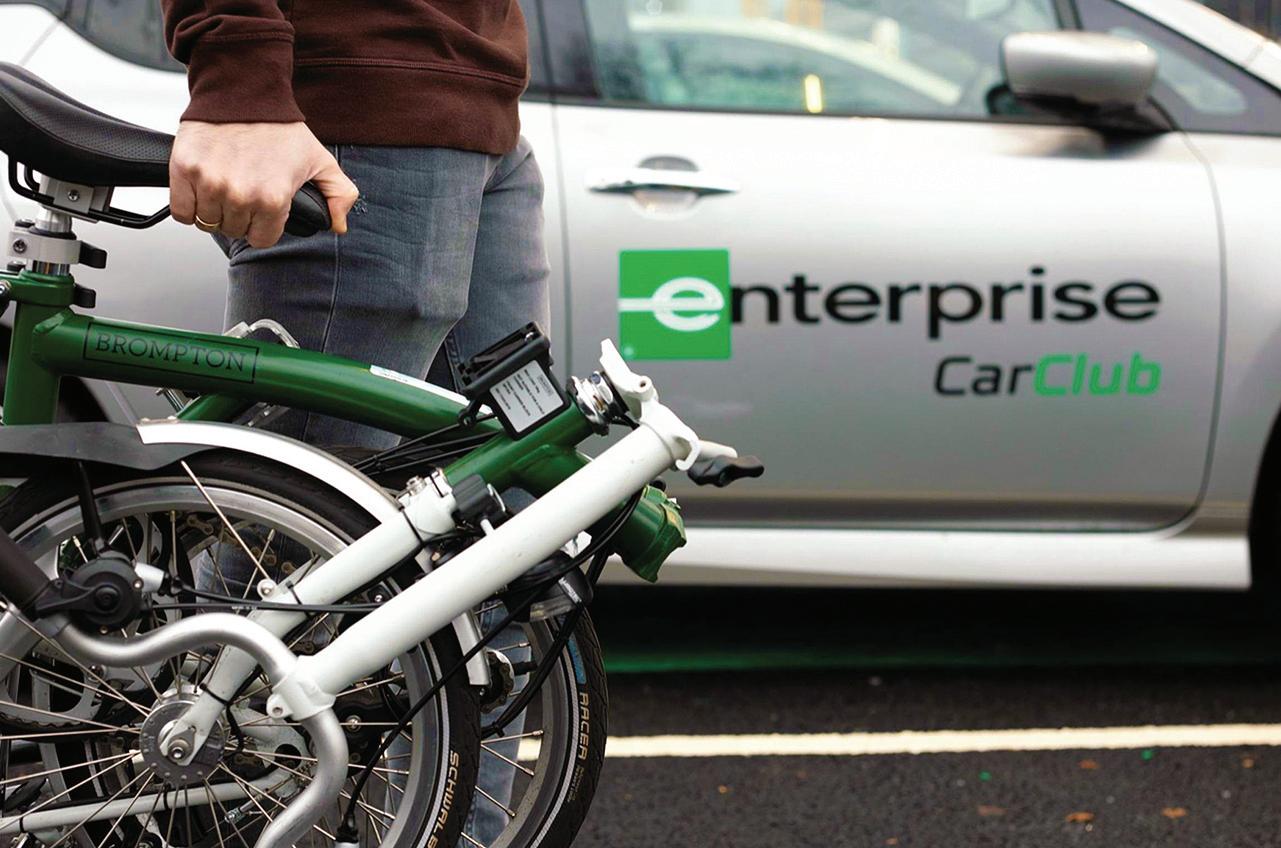
This led to a 52% rise in the number of journeys made by bicycle, and a 65% increase in active travel overall, while 38% of employees said that knowing they could access a car club vehicle at work if they needed it made it easier to consider commuting by bike.
Imperial research student Jonny Jackson said: “This is the first field trial that explores the real-world impact of mobility hubs on how people commute to work, and how they travel while at work.
“It indicates there is significant employee support for more active

and sustainable modes of travel, as long as people have the security of access to a car or a bike when they really need one for a journey.
“We were especially interested to observe that many of those taking part in the trial were planning to continue to commute by bike or another active travel mode, and that they were open to paying for car club usage on campus.”
Enterprise vice president for mobility for Europe Ben Lawson said: “This trial provides us with the first data-led evidence that workplace mobility hubs can encourage shared and active travel among employees, both for business trips and the com-
mute. We already have examples such as Highland Council showing the impact of employee car clubs on achieving more sustainable travel behaviours, which was included as a best practice example in the government’s recent Transport Decarbonisation Plan.”
The trial was operated over a four-month period and allowed Imperial to assess the impact on staff travel patterns by giving people more choices for sustainable and active transport. The hub also enabled Imperial researchers to examine how commuting patterns and day-to-day travel can be changed from relying on ownership to using
The Imperial College London hub offers shared cars and cycles
shared transport.
Professor Mary Ryan, viceprovost (research and enterprise) and college lead for the Transition to Zero Pollution Initiative, said: “This ambitious pilot project brought together researchers across college to explore one of the challenging aspects on the path to net zero. This interdisciplinary approach, coupling zero emissions technology with behavioural science and economics, leads to a solution that is both better for humans and the planet.”
Mobility Hubs 2022 takes place at 15 Hatfields London on 25 May www.mobilityhubs.uk
Q-Park’s Park Lane mobility hub in London has been nominated for a European Parking Award. Following visits to all nominees, the winner is set to be decided at a ceremony during the European Parking Congress, which is being held in Brussels during September.
The EPA Award competition is organised biannually and certifies car parks, services, on-street solutions, innovations and communication schemes. The judging panel is made up of parking experts from across Europe.
Q-Park UK has a strong history in the awards, winning two awards and being nominated on three other occasions.
Q-Park regards urban mobility hubs as way to develop parking facilities into facilities that increase urban accessibility, sustainability and liveability. In addition to car parking, Q-Park’s hubs provide access for shared mobility schemes, rapid electric
vehicle charging, last-mile delivery and retail space.
Adam Bidder, managing director of Q-Park UK, said: “There are many theories and designs for utilising parking facilities as mobility hubs. The Q-Park Park Lane mobility hub is one of the few real life working examples.
“Not only does the mobility hub provide
parking for visitors, commuters and residents, it also has a number of other mixed uses that can provide numerous benefits to the local community and environment.
“These include fast charging facilities for bp pulse fleet customers, electric taxi charging for Uber and Transport for London, electric car sharing operated by UFODrive, a DPD last-mile delivery centre and retail space for Enterprise Rent-A-Car.
“Naturally we are ecstatic to once again be nominated for a European Parking Award for our mobility hub at Q-Park Park Lane. It is testament to the excellence of our sustainable urban mobility policy that we are leading the way in our sector for the creation of mobility hubs. The hard work doesn’t stop just at the Park Lane car park, we aim to convert the majority of our estate so that we keep up with what is the future of parking.”

South East rail stations offer secure parking for cycles and electric bikes
Increased awareness of global environmental challenges is resulting in commuters changing their behaviour and increasing their use of bicycles and other micromobility vehicles.
With space limited on trains and restrictions applying on peak-time travel, cyclists are encouraged to leave their bikes at stations. Micromobility company Bikeep has been working with Govia Thameslink Railway (GTR) and APCOA Parking to offer secure cycle storage and e-bike charging to rail users.
The first Bikeep facilities have been introduced at Bedford and Harpenden stations. Customers can secure their bikes in Bikeep’s racks whilst continuing their journey by train.

David Gornall, commercial director at GTR, said: “We’re pleased to be partnering up with APCOA and Bikeep to provide charging points for customers
using electric bikes.
“In addition to EV charging points across our network, the new e-bike charging facilities at Bedford and Harpenden will support those making environ-
mentally-friendly journeys to and from the station and will hopefully encourage more rail users to consider this mode of transport.”
Kim Challis, APCOA’s regional
managing director UK&I and group ESG director, said: “The trend towards sustainable transportation is growing fast and as funds are directed to provide the supporting infrastructure, usage will further increase.
Partnering with Bikeep to introduce their secure storage and charging solution into the UK is an exciting step forward.”

Bikeep chief executive Kristjan Lind said: “With a tap of a button on your smartphone, your bike is locked securely from two points with a huge steel bar, the station is overseen by CCTV, and any distress signals are forwarded to local security whilst an audible alarm sounds. In addition, the same station charges your e-bikes while you’re away. A truly smart solution for a 21st century urban commuter.”
Bikeep operates in 21 different countries. In North America its technology has been used by San Francisco’s Bay Area Rapid Transit (BART) since 2017 and Canadian TransLink from 2020 to fight against soaring bike theft and to increase bike usage.


The parking sector, made up of private and local authority operators, has become highly fragmented. Acquisitions and estate takeovers have resulted in operators inheriting different hardware and the need to manage relationships with multiple gateways and acquirers, resulting in higher costs and substantial administration.
Simultaneously, consumers want a range of convenient and secure payment methods, and operators need to find ways to deliver this while speeding up funding, settlement and cash flow. Here are some key trends that the team at Elavon think will shape the parking sector in the future.
There is a lot of excitement around the evolution of mobility hubs: visible, safe and accessible spaces where public, shared and connected modes of transport are available for the benefit of all. They encourage the use of shared transport, such as bikes and scooters, improving the overall flow of traffic through towns and cities while enhancing local communities and businesses.
A mobility hub will often have a number of different transport options in close proximity to each other, allowing users to switch between travel modes with ease. We expect to see these hubs evolve in line with increasing use of connected devices, allowing users to track traffic volumes and plan their journeys with increasing efficiency.
There are several factors to consider before mobility hubs can be adopted more widely in the UK by operators and consumers in their dayto-day lives. For example, understanding who owns and manages a hub is crucial to ensure they are safe and secure to use by consumers and, importantly, who is accountable for fixing any problems if something goes wrong.
We are likely to see a closer relationship between car park operators and the consumer
The landscape pre-COVID was already changing as customers were moving away from cash to alternative payment methods such as digital and in-app payments.
The current climate is accelerating this change as consumers are looking for quick and contactfree interactions when paying for parking. As a result, we are likely to see a closer relationship between car park operators and the consumer, particularly with popular parking payment apps such as RingGo, PayByPhone and JustPark.

As cars themselves become increasingly connected, consumers will expect a wider variety of connected services for payments available from the comfort of their vehicles. This will provide a further boost to cities and town centres as it will encourage an increase in spending.
Connectivity, convenience and decarbonisation will be key Transport infrastructure needs to continue developing to meet increasing consumer demands for convenience. There is already a
part of the UK government’s 2050 net zero strategy.
While there has been positive progress, such as the growth of electric vehicles and increased use of bicycles, there is much more investment required to establish transport infrastructure that achieves a complete and sustainable journey, from leaving the house to returning home. This could include increased use of renewable sources of electricity, investing in more charging points to encourage the uptake of electric vehicles and encouraging consumers to shift to greener modes of transport such as trains, buses, cycling and walking.
Increased connectivity across the network and associated services such as payments, traffic management will be essential to creating more seamless and sustainable journeys for all.
trend towards using smartphone payments for most forms of travel and people can even book, pay for and board a flight without needing to reach for their debit card or print a physical ticket.
The expectation now is that we can arrive anywhere in the world and our transit experience will be simple, accessible, and unlocked using the tools that we already have in our pockets. We will expect even easier access to information, to travel updates, to the cheapest fare options and to seamless payments, wherever in the world we are.
Additionally, we will see continued effort towards building a sustainable transport network that will allow for mobility across cities and borders while working towards achieving de-carbonisation of the transport economy as
Elavon is a global payments company. A subsidiary of US Bancorp, Elavon provides businesses with technology to accept payments from customers, whether they are shopping in stores, at home or on the go.
Elavon also provides consulting services to propose solutions that standardise hardware, streamline payments relationships and simplify administration and processes.
Elavon has produced a whitepaper called Payments in Transit.
www.elavon.co.uk/content/dam/elavon/en -ie/documents/perspectives/ElavonPayments-In-Transit-White-Paper-Final.pdf
What does the future of transport infrastructure and payments look like? Patrick Doherty makes some predictions
Mobility hubs will evolve in line with increasing use of connected devices, allowing users to track traffic volumes and plan their journeys Patrick Doherty

Under the mantra to ‘Build Back Better and Greener’, the UK government’s Transport Decarbonisation Plan was published in 2021, highlighting plans for improving legacy transport infrastructure programmes by considering “how changing patterns of work, shopping and business travel might affect them”. From the series of ambitious transport pledges made by transport secretary Grant Shapps, we can see that the government has strong conviction its ‘greenprint’ will succeed in making travel much more sustainable over the coming years and decades.
In launching this green manifesto, the government has reaffirmed how committed it is to transport rejuvenation promises. And, as the UK carves out its own strategy separate to the EU, the document serves a reminder of the goal to ban the sale of new petrol and diesel cars in 2030, and that all cars must be fully zeroemission at the tailpipe by 2035. For this to happen, alongside other developments, widescale technological and social changes need to occur, and in a holistic review of transport, we need to ask – where does something like parking fit into the picture?
For councils working on the ground, revitalising parking will prove key in making transport more efficient and sustainable. Well-managed parking can keep the flow of vehicles running through towns and cities, connect shoppers with retail centres and local high streets, and parking data can illuminate important information about post-pandemic movement trends. Through local systems and authorities, parking can create big and tangible impacts for the UK as we focus on going green.
digital age for parking
Today, drivers are demanding the same digital convenience for mobility as they do for broader consumer goods and services. In observing this trend, the government has recognised that technology which is “increasingly automated and better equipped to meet user demands” will boost the resiliency and efficiency of transport. However, while the simplicity and convenience of digital solutions have done much to ease the stress of motorists, there remain frustrations.
When it comes to parking, poor UX (user experience) facilities, the arduous task of hunting for a spot, and a lack of payment choice are common pain points that feed negative perceptions.

To combat these challenges, customer experience will be improved through open data networks and digital solutions will be pre-built in vehicles. Integrated networks will power AIenhanced navigation tools, providing real-time intelligence on parking availability, and precise locations to drivers via smartphone notifications or their own native infotainment system displays –with some models so digitally advanced that they could rightly be considered ‘smartphones on wheels’. This new breed of smart vehicle is likely to be equipped with in-car payment solutions. Today, motorists often must pull up, park, then access their phones to make a cashless parking payment. As more advanced tech becomes widely available, this sequence will be far more streamlined, with their vehicles automatically taking care of all the payment legwork.
Outside of parking, open data networks will equip customers with vital information about a range of services designed to build convenience into their journeys; electric vehicle (EV) chargers, accessibility for disabled drivers, and air quality information, to name but a few. This will meet driver expectations and result in a positive shift in public attitudes towards parking.
Peter O’Driscoll looks at how smarter parking will support society’s move towards more sustainable mobility
EV drivers want the convenience of ‘plug-pay-and-play’ options
Drivers are demanding the same digital convenience for mobility as they do for broader consumer goods and services
Peter O’Driscoll

While the government has acknowledged that technology is “driving radical changes in transport, with profound implications for users and businesses”, keeping competition alive in the transport industry is what will ensure positive change continues to happen at pace. With parking, while the day of hunting for change to pay for a session is almost over, the friction associated with payment remains. Drivers expect digital experiences to be seamless, convenient, and intelligent. However, the volume and variety of parking providers has resulted in motorists having to download (or re-download) multiple apps, enter payment details, and fill out personal information repeatedly. In many ways, duplicating apps is even more frustrating than having to dig out your last 20p piece. Instead, allowing multiple digital parking providers to operate in the same car park should be considered a convenient and strategic option for the coming year.

Competition is healthy, driving parking providers to up their game in ease-of-use and accessibility. Instead of navigating numerous different apps, a single platform will let drivers select the payment service they most prefer, streamlining and de-stressing the parking process. In addition, it is good news for local authorities too, as competition will reduce the complexities and costs associated with tender processes and vendor switch outs, while helping to drive digital penetration as parking becomes easier for motorists.
Around one-in-ten new cars in the UK is electric, with uptake expected to soar over the next 12 months. Encouraging the switch to EVs will be supported by the legal requirement for new homes and businesses to have an EV charger installed from 2022. This can only be good news, given the imperative to act swiftly on global climate concerns and end the sale of fossil fuels in the coming decades.
As a result, 2022 will see growth of EV charging stations across the country. However, there are still some barriers to entry for would-be EV owners. A lack of charging service providers is a concern, as is the limited availability of high-speed charging point infrastructure. The absence of competition and a joined-up strategy between EV charging providers could inhibit the rapid acceleration of the required standardised infrastructure.
Hand-in-hand with EV charging is EV parking. Can these two essential elements be brought together? Drivers want the convenience of ‘plug-pay-and-play’ options, combining parking with charging while they go about their business – without having to set more aside time to ‘top up’ charge. To make this a reality, a streamlined digital system is required which allows motorists to pay for parking and charging simultaneously. We already see this taking place in Scandinavia today, and it must be a priority for the UK over the next 12 months, as we seek to mitigate climate change through cleaner transport.
With continuing concerns around COVID safety, many people are still wary of using public transport and prefer the comparative safety of their car. In our post-pandemic recovery period, while prioritising health and safety, things that discourage people from visiting our ailing town centres and cities must be reviewed.
Penalising motorists with hefty fines or inflated parking prices is a blunt tool, which can backfire. While they may inject shortterm cash for councils, high parking costs and fines are a disincentive to visitors at a time when local economies need steady, sustainable income. Councils must consider this balance carefully over the next year while we continue recovery.
Keeping the flow of vehicles through towns and cities will help shoppers access the high street and retail centres more easily. This will be vital to get store footfall back up and keep local businesses seeing customers, with parking playing a large part in the shopper’s journey.
While it is been largely successful and standardised in wider Europe, the open market is only starting to make inroads in the
UK. We have seen conversions in areas like Manchester, Cambridgeshire, as well as Bournemouth, Christchurch, and Poole. The open market is set to expand further, and this will help democratise data, with providers and third parties able to securely share and access important data to drive better digital services.

Co-ordinating the industry through National Parking Platform initiatives will improve the experience for motorists, while incentivising providers to innovate and offer the best sort of services. The open market provides additional reliability and efficiencies for those managing parking; there are several ways of implementing multivendor cashless parking, from integrated hubs, which support the widest possible parking, tariff, enforcement, environmental, and business intelligence solutions, to a simple multi-way enforcement integration.
Which option is best depends on local circumstances, the level of sophistication desired, and the answer to the question – how quickly do you want to get up and running? Open market offerings will also, over time, cut the internal costs of repeated procurement exercises. Once tender processes for an open market are complete, there is no need to carry out further procurement every few years, and this increases efficiency in the long-term.
•
s the world continues to focus on recovery and reinvention, one of the major challenges facing parking operators is how to successfully draw customers back into using their services. Restrictions have now, largely, subsided but in their place lies a plethora of other issues. The cost of living crisis, exacerbated by high fuel prices as well as inflation surging, is a large hurdle for the entire economy as increased prices impact spending habits and potentially the ability of merchants to maintain a sustainable profit.
Inflation and other geopolitical situations, affecting goods prices, have meant that many are rethinking how they spend their money and limiting time spent driving is one of the means by which some are choosing to do so. Instead of driving into their local town or city, for example, people may opt to take public transport, to save on both the cost of parking and fuel.
Being ahead of the game by streamlining payment systems is one way that parking merchants may enhance the customer experience and maximise the likelihood of repeat business. When it comes to parking, convenience is at the heart of what consumers have come to expect and that comes, largely, from having a frictionless and integrated payments platform in place.
Offering an increasingly invisible payment service, whereby an individual can pay without needing to enter a PIN number either through a physical credit or debit card is now an expected part of the new era payment experience and, in turn, is a must-have for merchants.
The move towards contactless is a trend that was accelerated by the pandemic as parking customers sought more contactfree and hygienic means of paying for goods and services with health and safety being a key motive. This method of paying minimised the chance of virus transmission and better protected these customers and their families. These unprecedented circumstances, along with the rapid rate of transformation experienced within the payments sector, have underlined how technology is being driven by bespoke customer needs.
In addition to accepting contactless payments through card or smart devices, the more technologically advanced car parks have implemented an app-based reservation system, which allows customers to pre-book a parking space and register their numberplate. Using advanced numberplate recognition, the customer can enter and exit the car park without needing to get out of their car to pay at a fixed terminal.
The customers’ card and numberplate details can be saved in the app, if permission is granted by the user, for future bookings – being able to pre-book a parking space is particularly helpful when the car park is close to a popular event or
Frictionless app transactions help keep customers happy
venue and finding a spot is difficult. All these factors enhance convenience for the customer.
To attract customers in a different manner, parking merchants may consider collaborating with retailers or with hotels by offering customers a deal. For example, merchants operating near or within a shopping centre may consider collaborating with a supermarket to offer food discounts if they use each other’s services. The same approach can be easily applied to other retail services and incentivises visits.
Adopting a resilient payments system will be crucial for parking merchants looking for long-term success as they confront the industry’s latest challenges. Those who enlist smart technologies to
provide a convenient and seamless payment experience will almost certainly begin to see higher rates of long-term customer retention and loyalty.
Going one step further by enabling a reservation service through an app will also limit undue stress. By implementing these distinct parts of a parking experience, car operators are in the best possible place to encourage customer loyalty and secure revenue in the long term.

Wicks is key account manager, parking and EVC at Worldline Global

For information about Worldline’s parking offer visit the WL Parking Payments Suite at www.worldline.com

Convenience is at the heart of what consumers have come to expect and that comes from having a frictionless platform Anthony Wicks
Resilient payment systems will be crucial for parking merchants as the world reopens for business, says Anthony Wicks


cheaper parking at or near their destination, as well as highlighting parking restrictions and parking zones via a user-friendly map.
Drivers are confused by parking information and restrictions, and are concerned by parking costs, according to research commissioned by AppyWay. OnePoll surveyed 2000 British adults in March 2022 about their views on parking. Almost a half (46%) say parking is the most stressful part of driving.

The survey revealed that a third (33%) say they never know whether there are parking restrictions, and 31% think the information about parking is confusing. Almost half (45%) think there is not enough information to tell motorists where to park and over a quarter (27%) get nervous that they have unknowingly parked somewhere they should not.

It emerged drivers are willing to travel a further five minutes away from their destination, or a ten-minute walk, to park for free. Which is maybe not a surprise given seven in 10 (68%) drivers are concerned by the price of parking, with people suggesting that parking should cost no more than 84p per hour. AppyWay kerbside data indicates that the difference between parallel streets can be over £5 per hour.
Only just over a quarter (29%) always plan where they are going to park before setting
off, whereas 47% will only do so if it’s a new destination – and one in six never (17%) plan and deal with it when they arrive.
Busy streets (31%), anywhere where parallel parking is required (29%) and residential roads with potential restrictions (29%) were the most dreaded locations to park up.
The research also revealed:
• when it comes to the act of parking, 62% rate themselves as being good at parking

• parallel parking is the most common style of parking people think they’re bad at (28%)
• 78% are left annoyed when other people park badly
• motorists will give up on a space over twice a week with 38% just carrying on until they find a space that works for them.
AppyWay has launched AppyParking+, a new app that assists motorists locate free or
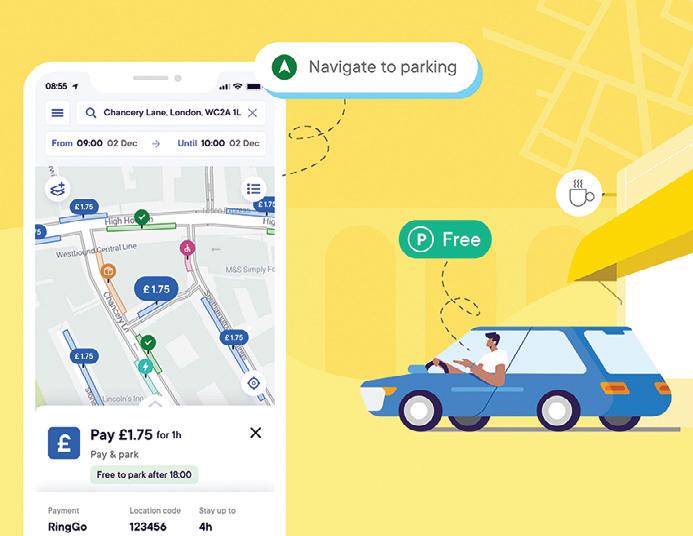



AppyParking+ has been designed tell users when a paid spot becomes cost-free and help navigate users to the nearest five parking bays to their destination. It also provides weekly operating hours and maximum stays for all bays, lines and zones. The app allows users to select a maximum walking time between parking and final destination.

Dan Hubert, chief executive and founder of AppyWay, said: “We know people can find parking stressful, as the research has shown, especially in busy cities with many restrictions and zones and costly parking charges. It’s been interesting to see the varying approaches to parking. We encourage people to get public transport when and where they can –which not only removes the parking stress completely, but reduces car emissions, which is better for the environment. When this isn’t possible, doing parking research before you head off can help save time, mileage and pounds by removing the rush and panic to find a space in unfamiliar or busy areas.
“The cost of parking is a major concern for motorists. Whilst we always encourage motorists to follow local parking signs and advice, AppyParking+ can help by giving you an informed choice on where to park, whether paid or free depending on the destination, and it clearly points out restrictions or zones.”

Half of motorists think there is not enough information on parking, reports AppyWayAppyParking+

Connected vehicle services provider Parkopedia is working in partnership with APCOA Parking Group to enable drivers to make digital parking payments from within their vehicles.
By leveraging automatic number plate recognition (ANPR) technology at APCOA’s car park locations across 13 European countries, drivers will be able to enter and exit car parks without requiring a ticket, or needing to stop at a pay station.

The integration onto Parkopedia’s platform allows frictionless payments. Known as Access and Pay, this process is designed to make parking payments quicker, easier and more convenient.
Drivers will not need to worry about incurring additional stay costs or fines because the solution allows digital payments for the total time of the stay without requiring further action from the driver.
The platform accommodates APCOA’s dynamic pricing structure, which applies different tariffs depending on the occupancy
of the car park, ensuring drivers can cover the total cost of parking sessions, regardless of any price fluctuations.
Parkopedia promotes its platform as a solution to the timeconsuming task of aggregating a large number of service suppliers and payment providers for automakers, uniting them into a single integrated solution.
The use of single sign-on technology is designed to replace the need for ‘Bring Your Own Account’ solutions that require drivers to manage multiple accounts, which can be affected by limited service coverage and require solutions such as ‘screen mirroring’ through smartphones that can distract drivers while
at the wheel.
APCOA Connect, the company’s digital platform payment service in the UK and Ireland, will integrate into Parkopedia’s in-car payment platform, allowing drivers to pay for both on and off-street parking, as well electric vehicle charging, tolls and pay-at-the-pump fuelling via the vehicle’s infotainment screen.
Parkopedia and APCOA previously collaborated as part of Mercedes-Benz’s Intelligent Park Pilot for the S-Class, enabling reservations and parking payments for vehicles parked using Autonomous Valet Parking (AVP) technology.
Frank van der Sant, chief commercial officer at APCOA Parking
Award winners announced at expo’s 2022 opening ceremony
Road safety, parking management and climate resilient traffic technology were among the winners of the Intertraffic Awards 2022.
The winners were announced at RAI Amsterdam in the Netherlands during the opening of the expo’s first event in four years. The last edition of the exhibition took place in 2018, with the 2020 event being cancelled due to the global pandemic.

The awards were presented by jury chairman Pieter Litjens, managing director of Dutch transport knowledge-sharing platform CROW. Litjens explained how an international jury of industry experts whittled a field of over 120 entries, first down to five nominations in each category, and finally to just one winner for each award.
“All the winners have been inspired by tackling problems we face in society,” said Litjens. “Whether that’s improving traffic safety and reducing fatalities or enabling better use of infrastructure and reducing emissions. All the winners have a drive to improve society and provide it with better solutions. The Intertraffic Awards help to focus the industry on improvement and success. And the winners get the extra attention that makes it possible for them to spread their message even further round the world and have the impact they envisaged.”
Intertraffic User Experience Award
Toogethr Parking by Toogethr, Netherlands
The Toogethr Parking solution helps organisations and parking operators make more efficient use of existing capacity. The easy-to-use interface particularly impressed the jury with its dynamic, demand-responsive interface that can also help to enable multi-modal travel and ridesharing.
Intertraffic Green Globe Award
TraffiPole by Jenoptik, Germany
The TraffiPole enables ITS hardware to function in hot climates without the need for air-conditioning. It impressed the judges as a simple, easy-to-deploy concept, with instant benefits in reducing energy consumption, and thus CO2 emissions.
Group, said: “Our partnership with Parkopedia allows us to take our already successful automated parking and charging payment solution to the next step in driver convenience and mobility services.
“Our customers will now be able to benefit from our technology directly from their incar infotainment screens without taking their focus off the road and allowing drivers to get valuable time back with peace of mind that their parking and charging payments are completely taken care of.”
Hans Puvogel, chief operating officer at Parkopedia, added: “Our partnership with APCOA is a huge step forward for driver convenience technology and mobility services. Parkopedia is able to substantially increase our payment platform’s parking coverage across Europe, while APCOA can now integrate its successful parking payment services directly to the driver from within their vehicles as part of complete seamless mobility.
“Together, we will meet the demand for digital and automated parking services and provide lasting positive parking experiences across the continent.”
Acusensus Heads Up by Acusensus, Australia
Acusensus has developed an automatic detection system that addresses the problem of mobile phone use at the wheel. The jury felt the solution led the field when it first became commercially available at the start of 2020, providing inspiration for enforcement solutions that is still felt today.
SCReWS by Aisico, Italy
Aisico’s ‘screw-in’ system allows crash barriers to be installed and withstand the extreme force of an out-of-control vehicle, even where soil is weak. Although not an overall winner in its category the jury felt Aisco’s system deserved special mention to SCReWS (Save Crash Reinforcing Weak Soil) because it was a simple yet highly practical and extremely useful solution that could have real safety benefits.
• Pieter Litjens, director CROW (chairman of the jury)
• Margriet van Schijndel, programme director for mobility, TU Eindhoven
• Jorrit Weerman, chief executive, Parking Network
• Tom Stone, editor of TTi and iVT and Intertraffic World Magazine
• Adam Hill, editor of ITS International www.intertraffic.com
Drivers will be able to pay for parking using in-car systemsThe Toogethr team
We are connecting the dots of a new mobility revolution that is transforming our towns and cities.

With the broadest end-to-end portfolio of intelligent traffic management solutions, we work with cities, highway authorities and mobility
operators to make their road networks and fleets intelligent, enhance road safety and improve air quality.
It’s time to make the world a better place. We are ready. Are you?
Grid Smarter Cities, a software solutions provider, and Buchanan Computing, a mapping and IT specialist, are launching a new integration to support local authorities with planning and mapping their bookable loading bays using onstreet parking data.
The integration will link Grid’s kerbside management product, Kerb, into the ParkMap software.
Kerb is a platform and app that allows kerbside slots to be booked in advance by parcel and delivery companies. This enables delivery drivers to have certainty that they will have a place to park to drop off goods or unload heavy deliveries on arrival to their destinations.
ParkMap is a solution for creating digital traffic orders, providing local authorities with a map-based inventory of parking
and moving traffic regulations.
Integrated with this are full facilities for the order-making process, to aid productivity and keep the permanent records updated.
ParkMap can be used to manage and communicate a regularly changing set of traffic orders.
The integration now combines this functionality with Kerb.
Neil Herron, chief executive and founder of Grid Smarter
App unlocks detailed parking and loading restriction information
Digital kerbside management and parking technology firm AppyWay has launched a new parking app called AppyParking+.
Building on the company’s existing parking app, AppyParking+ is designed to act a co-pilot for drivers, offering new features designed to help drivers find the cheapest and nearest parking to their destination.
Leveraging AppyWay’s data on 5 million miles of digitised, standardised and centralised kerbside across the UK, AppyParking+ will target London and aim to slash up to
12 minutes off the 4.6 million trips that happen every day.
AppyWay said its kerbside data has shown that the difference in cost between parallel streets can be over £5 per hour and with PCNs averaging £60 across London.

AppyParking+ is available for free or via a subscription that unlocks additional time and money saving features. Premium subscribers can access exclusive parking insights such as intel on when paid bays will become free, or whether the next street over has cheaper parking.
Features new to AppyParking+ include turn-byturn navigation to the nearest five parking locations to your destination along with a clear
Mobile parking payments provider PayByPhone has launched its global app in Italy.
PayByPhone, which launched in Italy in 2018 as a single country app, is now expanding and has officially become part of the global PayByPhone app. This means the more than 50 million global PayByPhone users will now have access to

pay for parking simply and remotely in 100 cities in Italy, including Verona, Turin, Bologna and Naples.
Additionally, Italian motorists will now be able to use their PayByPhone app to park in more than 1,200 cities worldwide where PayByPhone is present, including Paris, Brussels, Geneva, Amsterdam,
Cities, said: “As awareness of the operational, environmental and societal benefits of effective kerbside management grows both at national policy level and a local implementation level, the benefits for the freight, servicing and delivery sectors can start to be realised along with the congestion reduction and air quality benefits for local residents and businesses.”
The integration of the Kerb
view of walking times.
Dan Hubert, founder and chief executive of AppyWay, said: “I am thrilled to have finally launched AppyParking+ which is the complementary product to our award-winning GovTech digital traffic management platform. Since our inception I have been championing the need to put quality parking data into the hands of every driver so citizens can make informed decisions about their destination and choose what mode of transport to take.
“Our growing customer base of local authorities and AppyParking+ users mean that we can all collectively help reduce the unnecessary miles driven and do our bit to help achieve carbon zero targets.”
Lausanne, London and San Francisco.
“PayByPhone’s goal was always to create one global app, on one global platform, servicing the world,” said Andy Gruber, PayByPhone’s chief executive officer.
“Bringing Italy on board is the next step along this journey, with plans to launch Germany onto our global app later this year.”
Platform will help local authorities to seamlessly implement and manage bookable loading bays and coordinate delivery activity, said Herron.
He added: “Giving local authorities more control over how they manage what is a stretched piece of real estate with more flexibility in real-time while also opening up the possibilities for multiple use cases. Think delivery bay by day, streeterie in the evening and taxi bay by night.”
Alex Smith, managing director of Buchanan Computing, said: “We very much welcomed this opportunity to work with a likeminded company focussed as we are on delivering innovative solutions to the UK’s ever growing number of smart cities and towns. To achieve the benefits of improved kerbside management, we have created a new endpoint to our API service, enabling a continuous flow of up-to-date data to be consumed by Kerb.”
The City of London Corporation is extending its collaboration with cashless parking provider RingGo for a further five years.
The relationship between RingGo and the corporation dates back to 2017. Over the past five years the City of London has removed pay & display machines, made RingGo its sole parking provider and implemented Emissions Based Parking.
Peter O’Driscoll, managing director of RingGo, said: “We are thrilled to remain the incumbent parking provider for the City of London. This doesn’t mean we’ll rest on our laurels when delivering quality parking services. We remain committed and excited at the prospect of developing groundbreaking parking solutions that continue to bring efficient service to our customers, whilst also contributing towards a greener environment.”
• Hertfordshire’s Borough of Broxbourne Council has appointed RingGo to supply its cashless parking services. The two-year contract launched on 1 April.
RingGo’s service lets drivers book, manage and pay for parking through their smartphones.

Watford General Hospital’s new multi-storey car park has opened on time and on budget. The facility has been created by West Hertfordshire Teaching Hospitals NHS Trust to provide space for patients, staff and visitors.
The £40m car park was designed and built by HUBER Car Park Systems.
The seven-storey structure has 1,454 spaces, of which the hospital has 1,289 and 165 are allocated to Watford Borough Council with the proviso that staff cannot use them.
There is capacity for 124 electric vehicle charging bays, which will be made available as demand increases.
There are 70 disabled parking bays, almost double the total currently available. The disabled parking bays are at the closest point to three fast, fully-accessible lifts on all floors.
There is a ‘parking hub’ which is staffed 24 hours a day.
West Hertfordshire Teaching Hospitals NHS Trust serves people from across Hertfordshire, north London and further afield. It operates from three hospitals; Watford General, St Albans City and Hemel Hempstead. The trust has a catchment area of over 500,000 people and
employs around 5,000 staff and volunteers.
The trust is currently developing a green travel plan as part of its sustainability strategy and to support the NHS targets for achieving net zero carbon by 2040. To contribute to this, the multi-storey car park features photovoltaic roof panels which provide renewable energy for the hospital.

Access to the car park is from Thomas Sawyer Way. A pedestrian bridge from level 2 removes the need to walk up and down the steepest part of the slope at the site.
Charges and concessionary rates have been reviewed. Public charges have been set to be in
line with other hospitals in the region.
The car park operates on a pay-on-exit basis using ANPR (automatic number plate recognition). Staff parking charges are tiered to reflect salaries and will move from a monthly deduction to a ‘pay as you park’ system later this year.
Income from charges is used only to pay for parking-related costs. The trust said the fees are necessary to help cover the costs of running the car park including: capital charges arising from the £40m build cost; ground rent; the staffing; lighting; technology and maintenance.
There had been some national funding which allowed NHS
hospital staff to park for free but this ceased at the end of March 2022.
Free parking is offered to:
• carers who are assisting patients at meal times and with other care
• next of kin of patients who are receiving end of life or critical care
• parents/carers/guardians of children who are inpatients
• patients who attend outpatient clinics three times or more each month over a period of at least three months
• Blue Badge holders
• concessionary rates (£24 per week or £48 per month) are available for very frequent attenders
• patients and visitors can now park in any space for up to 30 minutes free of charge, making it much easier to drop-off and collect people.
Car parking charges at the hospital sites apply 24 hours, Monday-Sunday.
Paddy Hennessy, the trust’s director of environment, said: “Staff feedback has been very positive and we are looking forward to welcoming patients and visitors to the new multi-storey car park. Local people should take heart that we have completed the new multi-storey car park on time and on budget as this bodes well for our exciting hospital redevelopment plans.”
A new 1,600-space staff car park has opened at University Hospital, Coventry as part of a major infrastructure project that will also further improve the experience of patients and visitors.
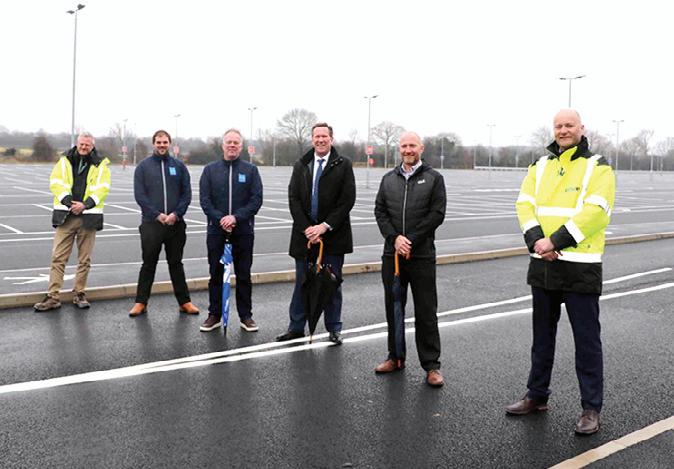
Staff Car Park 11 has been developed by University Hospitals Coventry and Warwickshire (UHCW) NHS Trust in partnership with health and care property developer Prime. The building was constructed by Montel Civil Engineering.
The creation of a dedicated staff car park means parking at the front of the hospital can be prioritised for patients and visitors.
A total of 34 active electric vehicle (EV) charging spaces have been included in the new car park. There are also 46 currently passive charging spaces which can be activated to meet future need, believed to be the largest number provided by any NHS Trust in the country.
Parking spaces for 34 motorcycles has been created, along with spaces for bicycle parking areas.
Professor Andy Hardy, chief executive
officer at UHCW NHS Trust, said: “The new car park will have a potentially gamechanging impact on staff, patients and visitors – delivering an enhanced experience of accessing the hospital. By providing more dedicated staff spaces the Trust will also be better able to recruit and retain staff.”
Staff Car Park 11 features CCTV cameras and a dedicated short access route to the back of the main University Hospital building to enhance user safety.
UHCW NHS Trust has allocated permits
across differing shift patterns to help support traffic flow across the site.
Following community consultation, it was decided the sole entry and exit point for the new car park would be via Clifford Bridge Road using the existing routes through the hospital campus.
Will Bilbrough, technical development director at Prime, said: “UHCW NHS Trust has been trying to find a way to further increase capacity at University Hospital, Coventry for a number of years. By working with the community, local councillors and the trust, we are proud to have devised a solution through this development allowing UHCW NHS Trust to continue to focus on delivering their outstanding service for years to come.”
Simon Turbutt, managing director at Montel Civil Engineering, added: “This is an extremely prestigious project and a fantastic addition to the facilities at University Hospital, Coventry which will really improve the parking conditions for staff and patients.”
Two new multi-storey car parks have been completed for Sandwell and West Birmingham NHS Trust. Between them the pair of car parks provide nearly 1,000 new spaces for staff and patients. The new car park at the City Hospital provides 500 spaces, while the one at Sandwell Hospital provides 400.
Estates development partner Prime progressed the plans for the new car parks, whilst law firm Capsticks advised on financing the buildings. Car park operator Q-Park will run the facilities.
The car parks were constructed to support the development of the hospitals.
The City Hospital is due to be redeveloped over the coming years to incorporate new housing and commercial space. It will continue to provide health services at the Birmingham Treatment Centre, the Birmingham and Midland Eye Centre and the Sheldon Block.
The Sandwell site, meanwhile, has undergone significant
changes over the past year, with the opening of Lyndon Primary Care Centre, a £6m development.
Richard Beeken, chief executive at Sandwell and West Birmingham NHS Trust, said: “We’re delighted to be opening these two multi-storey car parks which will significantly improve

the quality of access for those coming to our sites. Attending hospital can be a stressful experience and it can be frustrating being unable to find a parking space. These facilities aim to take away that stress for our patients and visitors. It will also mean staff are able to park with
ease when they arrive at work.”

Ewan Forsyth, development director at Prime said: “We are very proud to have delivered two new car parks with building work on both facilities completing on the same day.
“The logistical and practical challenges of constructing the two builds in tandem have required close working between all parties involved. The result of this team effort is a hugely improved parking experience for staff, patients, visitors and future potential released for both Sandwell Hospital and City Hospital, who can now make better use of the space they have on site.”
While the new multi-storeys were being built, Q-Park took on operation of the hospitals’ existing surface sites. It worked to ensure that these operated smoothly and that the extensive building work did not disrupt the work at the hospitals.
Adam Bidder, managing director of Q-Park UK, said: “The provision of quality parking is vitally important for the smooth operation of the healthcare system. We look forward to a long partnership with the NHS trust.”



Leeds University’s multi-storey is a beacon of smart thinking, writes David Peach
From a small village in the 13th century Leeds has grown to become a city of over 800,000 people. Inevitably then, mobility has been a major focus for the city. The city pioneered the urban motorway when the A58(M) opened in 1964. The loss of houses and buildings to make way for the road was not popular, but it represented the progressive approach to the car, common at the time.
Times have changed. In common with most educational establishments, the University of Leeds has made a commitment to sustainable travel and car parking on campus is limited. However, parking is still needed, so when a decision was taken to build a new car park, this provided an opportunity to improve quality and safety in a re-imagined landscape.
The development had the over-riding aim of delivering a net-positive impact on campus biodiversity through new planting and an increase in pollinating plants.
Designed by CJCT Architects and built by Wates Construction, the multi-storey car park at the University of Leeds opened in 2016, making a striking yet subtle addition to the campus landscape, especially at night.
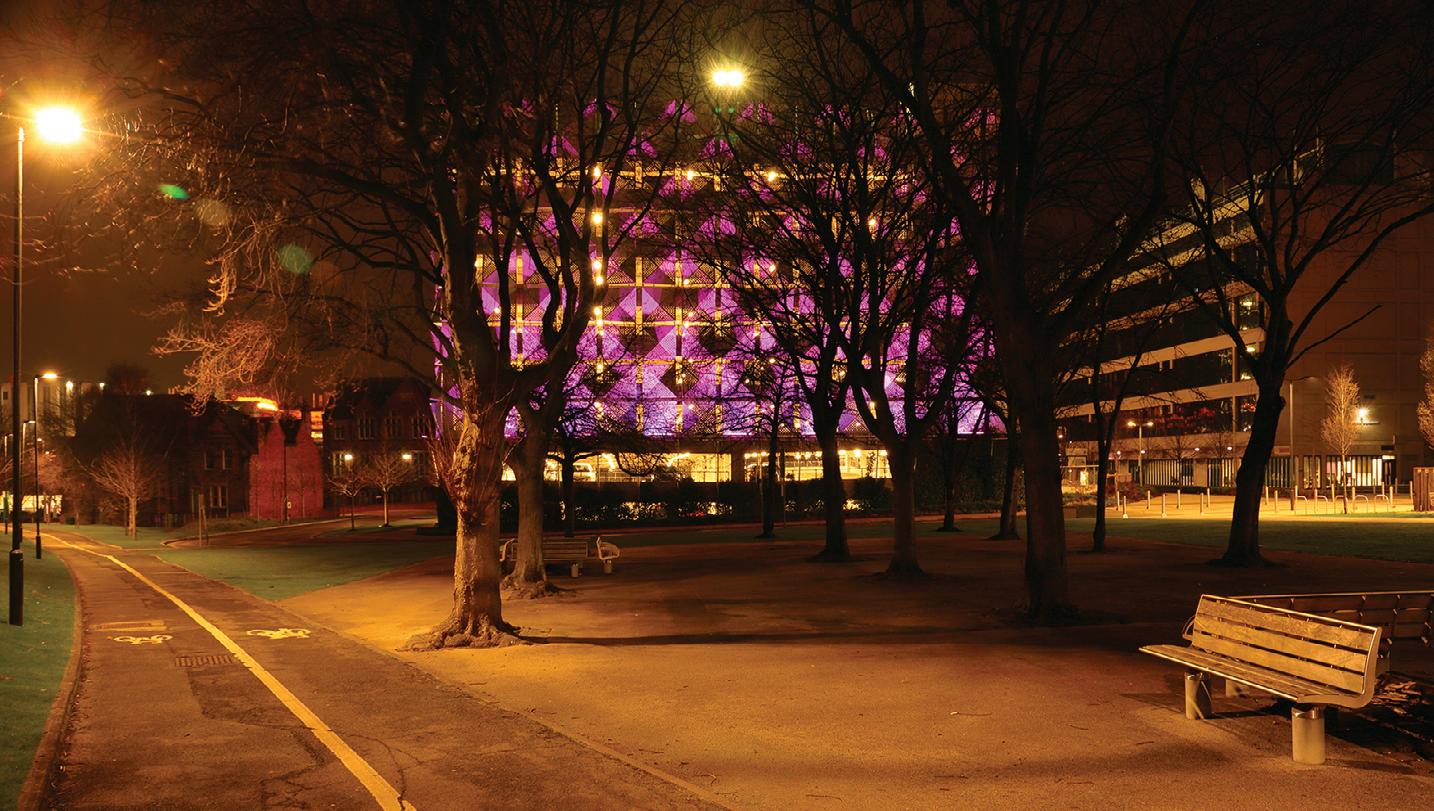
The innovative design features perforated metal panels that are illuminated at night.

The panels provide natural ventilation and are lit using energy efficient LED’s that change colour.
The effect of the car park in the evening when viewed from the eastern approach is not dissimilar to a southern European public square with an avenue of trees drawing the eye to the colourful façade. This is complemented by plentiful seating among the hard and soft landscaping.
Cycle and pedestrian paths sweep through the landscape providing safe alternative ways to get around.
As well as a work of striking architecture the university’s modern car park represents contemporary thinking around the place of the car in a modern city and the balance to be drawn with other forms of transport.
David Peach is managing director of Workflow Dynamics and business development director of The Parking Shop. He is also a creative photographer with an interest in urban landscapes.
www.davidpeachphotography.com Instagram @davidpeachphotography















